#i finally get to include ONE System of a Down reference in my art
Explore tagged Tumblr posts
Text
Came across some slasher band AU art by @arkunder and started frothing at the mouth
I like to imagine they'd do really performative concerts with the ghostface persona, like "killing" actresses on stage and being overall destructive to the point of losing gigs in nicer places so their fans don't completely wreck everything in a mosh pit (that they initiated) lmfao


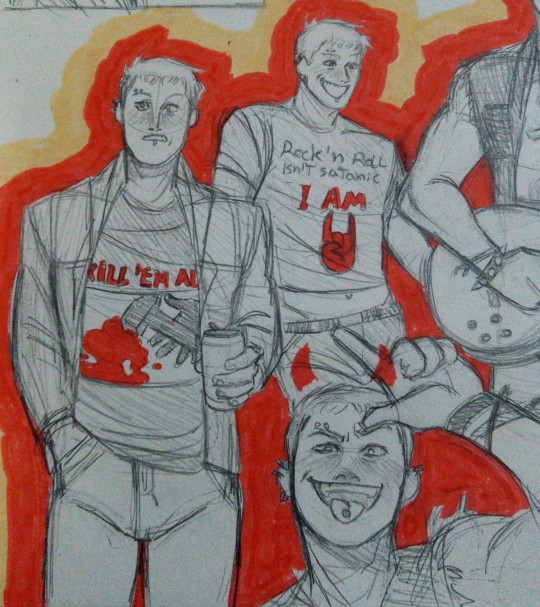
Stu's the campiest bitch on the block (as expected)
#I'm sorry I'll stop with the AUs now LMFAO#i hate drawing guitars. oh my god what a nightmare#Billy needs to physically restrain Stu so he doesn't grow an 80's inspired mullet#is it too obvious that Stu's my favorite out of the two#if swooning over matthew lillard all the time was a job then brother I'd be employee of the year#scream 1996#slasher band AU#stu macher#billy loomis#latenightsundayblues art tag#i finally get to include ONE System of a Down reference in my art#as a treat
199 notes
·
View notes
Text
School rant, sorry its kinda rambly. TW for school shootings, bomb threats, the whole Apalachee High situation.
Nothing like last week's news to make me so, so glad I’m not in a classroom anymore.
I taught in Georgia and South Carolina for 13 years. Even did an observation at Apalachee during grad school, since it was a relatively quick drive from Athens/UGA - you know, back in the distant past of 15 years ago when teacher training had actual rigor and requirements in this part of the country. I even taught at the psychoeducational alternative school that Barrow county bussed their most extreme EBD kids to. So yeah, this hit close to home for me.
My financial situation basically changed overnight last year, when Dr. Mr. Camucia finally finished his fellowship and became a full-fledged attending. This let me quit my job right in time for South Carolina to implement its policy where teachers would have to submit every. single. thing. that would be used throughout the year. Every book, website, lesson plan, PowerPoint - all would have to be submitted within the first two weeks for administration to approve, and parents would have the right to veto or challenge anything they want. You know, in addition to the million other things teachers already do, and crap I had to do handling the yearbook.
(You can only imagine what a policy like this would be like for me, teaching a class called Media Art where both teaching Photoshop and media literacy/criticism were in my standards 🙃)
But things, particularly where I was teaching, were already Bad. And, in fact, getting Worse. This was a school where we already had an entire year of bomb threats well before Covid (including one with an actual failed bomb! My fanfic Footnotes was borne of the insanity of that year!) - that basically showed the exact protocol of what happens when something like this happens at a school. We did all the things everyone claims would stop this sort of thing -
-They added metal detectors (which basically flagged almost everyone, causing 1st period to basically lose 20 minutes a day since so many kids had to get wanded down every morning). They gave up on those after about a week.
-They added more cops, more cameras, sealed off more doors, did all the things, but the bomb threats, kids bringing in weapons, etc. just kept happening.
-They even (years later) added a security system very similar to the one at Apalachee - except, oh, wait - my classroom, and like six others were just… not hooked up to the system. They took my old school panic button, said they’d fix it "later" and give me one of them fancy lanyards with the panic switch, and that just never happened. Three of the classrooms didn’t even have the fire alarm work for their room! They straight up missed fire drills!
My last year there, there was a huge fight in the cafeteria. Like the kind that makes the news, not the kind that happen almost every day that just get posted to tiktok or whatever (I was on bus line afternoon duty, and frequently had kids compliment me on how bored I’d look breaking up those kinds of fights).
But this was a 10 or so person brawl that ended up with multiple student injuries, blood all over the floor, a whole school lockdown, and a teacher breaking their leg trying to hold back the crowd watching/recording/cheering it on. I taught two of the main participants - they were suspended, then "expelled," then mysteriously just showed back up a month later after some sort of appeal to the board of ed. I was told to let them make up any work they missed during their month off, which they both referred to like it was a vacation (would it surprise anyone to know these were football players?).
This isn’t isolated. Ask almost any teacher and they’ll have multiple accounts of kids just… not facing consequences when they get written up, or not caring about parent calls (because the parent doesn’t care either), or seeing ISS and OSS as vacations since they just get to sleep and play with their phones. I don’t think people who haven’t been in a school realize just what it’s like now. And I don’t know what the environment was like at Apalachee, but I know that the facility where the most troubled kids for that specific part of Georgia was shut down last year - I know this because I worked there.
Apparently all of the GNETS (Georgia Network of Educational and Therapeutic and Support) schools in Georgia were shut down last year for having these kids not mainstreamed enough. I can say from having worked there as an art teacher that the system was not perfect, but that these kids did not belong in a mainstream classroom. I was stabbed, kicked, spat on, had literal shit thrown at me - and I was one of the better liked teachers! But at least there were smaller class sizes and much better ratios of social workers and psychologists working with the kids and their families. We had access to resources that regular public schools are just stretched too thin to pursue, things like getting families off the street, clothes and food for students' whole families, etc. So these kids were just sent back to their home schools for their presumably already overwhelmed regular Special Ed departments to deal with.
Apparently in Barrow County, where Apalachee is, all of the kids who were at the alternative school are sent to just one school per level, plus taking on additional kids from other, smaller counties in the area. I’m sure caseload numbers went way up, and the behaviors being dealt with got a whole lot more extreme in just one semester.
This kid should have had so many red flags. There already were, according to the FBI! But as far as schools, there should have been a dozen counselors, administrators, etc. who had worked on a fat ol BIP (behavior intervention plan) about this kid that every teacher got before he even stepped foot into their classroom. It’s not uncommon to get kids where you know for a damn fact you’re not supposed to let them go to the bathroom unaccompanied, or have to check in with guidance every morning, or who have to get their backpack searched every morning (or aren’t allowed to have a backpack at all! I had a few of those!). But that apparently just… didn’t happen.
So, yeah. Every part of this whole situation has just made my skin crawl. Those kids and those teachers should be alive. Those kids who got shot and will be traumatized for life should have never had that happen to them. The cult of gun worship in this country is sickening, and the more we gut public education, the more teachers will just throw their hands up and give up like I did - this isn’t going to get better without drastic, dramatic change. And I really just don’t see it happening in this country.
I miss teaching. I miss my kids. I was, by all accounts, pretty damn good at it. But with things the way they are, and the sheer insane number of things we expect teachers to be able to do while also blaming them for everything, I'm not going back.
#ranting about public education#public education#teacher rant#teacher stuff#teaching#teacher#apalachee high school
6 notes
·
View notes
Note
5 for the ask game?
Warning for uncomfortable teeth discussion and teeth drawings.
After all these years... I've finally finished it. WE'RE TALKING ABOUT GHOUL TEETH! The amount of time I've spent on this really makes it feel weird but the longer I dwell on that the more it actually is, so without further ado.
(The numbering system was mostly for my own convenience when trying not to lose these pictures that all look the same at first glance, but I kind of adapted to it as I was writing this.)

A1 is a pair of human teeth drawn by yours truly. The cuspids will typically be a bit duller, but otherwise these are pretty average, if poorly drawn. These will be your point of reference because pointy teeth can look normal when not compared to how genuinely flat our teeth are.

Now we have B1, this is the mostly widely recognized kind of ghoul teeth, used in scary propaganda and horror films, very vampire-esq. Sharper cuspids, slightly slimmer teeth, but difficult to distinguish if you're just walking past, or even taking a good look without a point of reference.
Some ghouls with noticeable B1's include the Kirishimas, Itori, Nishiki, Donato, Yumitsu, and Tatara. But! Here's the thing, there's actually two kinds of common ghoul teeth and this one's actually found with less frequency than the other kind,
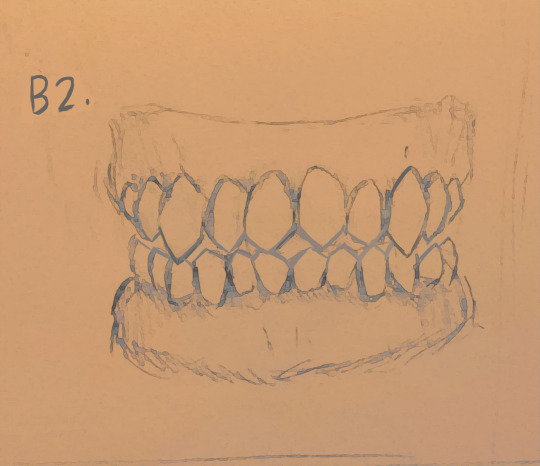
B2, almost all the teeth are more pointed than the human counterpart, but typically a bit more dulled than this example.
Some ghouls with noticeable B2's are Naki, Kanae, Irimi, Koma, Hinami, Roma, Miza and Shikorae.
Now we've dealt with the fun art stuff, time to get into the technical nonsense that I frankly know too little about dental functions to speak on but you cannot stop me with anything short of death itself. Proceeding! (There will be more fun art stuff further down)
The public is vaguely aware that there are actually two kinds of teeth distinctions that ghouls can have but it's more of an obscure trivia bit than common knowledge unless you work for the CCG, "You can tell an octopi's gender by whether or not it has suckers on the third arm to the right." type of factoid. Shirazu was actually pulled aside by investigators quite a few times times before even undergoing the Quinx procedure, just because his teeth give the impression of an unfortunately noticeable B2 ghoul. They had a record of him in the office for those working in the area he used to live in, that pretty much boiled down to "He's not a ghoul, please do not attack or interrogate if encountered in the wild, he's just Some Guy."
He's built like that for the same reason he was a good candidate for the Quinx procedure.
When it comes to concealment, It's pretty common practice for ghouls to have something extremely hard to chew on in order to seem to have completely average teeth, but if that's not their thing the bolder ghoul can just go the Uta route of "It's a body modification"
But in general dentists aren't a great idea unless you're a fortunate ghoul with naturally passing teeth, and even then only in necessity. Which is why it's remarked in confusion that Hajime Hazuki's teeth are "so straight," if he were a ghoul by birth that shouldn't really be the case.
Even now they obviously posses much stronger bite forces and teeth than any human, but this is actually quite a step down from ghouls of old. When integrating themselves into human society wasn't strictly necessary outside of simplifying hunts, the best comparison I can think of is monkeys. You'll see an actually drawing of roughly that in the next part...
This series has an unfortunate amount of unethical experiments, breeding, and hybridization fuckery, and this would feel incomplete if I didn't make an attempt to acknowledge that!
First off biological half ghouls. They're kind of a toss-up, they'll never have teeth as sharp as their ghoul parent, but there's a chance they'll only get certain teeth or none at all. Eto's the prior kind, her cuspids are a little pointy but she could easily pass as entirely human. I don't want to think about Ichika for any longer than I have to so that's all you're getting.
Artificial half-ghouls, Oggai and Quinx! They don't just magically grow sharper, your human teeth stay perfectly normal but the shift happens when they're broken and have to regrow after time/reaching a high enough frame, kind of an inevitability for artificial half-ghouls because human teeth are not made for ghoul shenanigans.
Amon gained a pretty good set of B2's but Takizawa's look a little like a weird yet subtle mix. (Not every ghoul falls neatly into one category or the other, but the vast majority do.) Kurona and Nashiro both ended up with B1's, Mucchan is a B2, Shirazu is as well but there was barely a change, Urie's a B1 and Saiko's never had to regrow her teeth but she'd be a B2. Aura, Higemaru, and Suzu are B2, Hsiao and Ryuusen are B1 but whether or not this has been shown is arguable.
Kaneki's teeth remained stubbornly humanoid regardless of how many times they were removed. Back when he had his mask made, Uta took note of this as an interesting trait and that's why the zipper-teeth are such a central feature. The Oggai are similar, but they were pretty good at keeping their human teeth anyways. More about this and the fruit bastard you'll notice is lacking from the half ghouls in a little.
Now the... breeders? What would you even call these three groups. Blades, Tsukiyamas, and Washuu Clan. The Blades aren't really interested in striving for appearances so they just have a mix of the two, mostly B2's with a couple B1's.
It gets a little more interesting for the other two.
The Tsukiyamas not only refine their ghoul traits into unique appearances, they pride themselves on those qualities and have the money to get away away with it. Their Kagunes may not be the strongest but by god do they draw the attention of the whole room in terms of unique mutations. So too are their teeth! Mirumo's are impressively noticeable B1's by themselves, but the real star is Shuu. Primarily inherited from his mother, they're one of the closest things to and old ghoul's teeth you'll find in the modern world. (Pictured bellow)
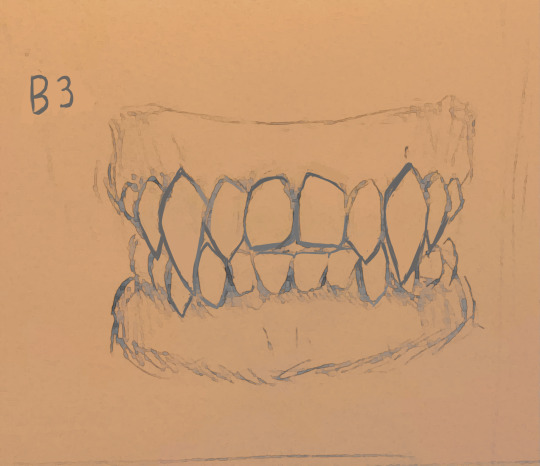
Outside of his pure influence, knack for luring in good dishes and wealth, part of the reason he's so liked at the restaurant is that he's just capable of ripping things up in a way that very few modern ghouls can. It's great fun to watch, but he rarely agrees to do so the first time around on account of his preference for actually prepared dishes and "polite" behavior, not to mention ghouls generally don't like to eat in front of others. But few are entirely immune to persuasion, and Shuu certainly isn't among them. It's quite the spectacle. Downsides: They're kind of awkward for such a verbose person, and if he bites a little too hard he can take his tongue clean off without meaning to. It'll grow back quickly but it's definitely not fun.
Now for the Washuu garden, where the only the thing they're growing is broken kids and misogyny.
As Rize states, the more human you are the "better" you are to them, and this extends to physical appearances as well. So, even the ghouls posses pretty human-looking teeth, but for most branches there's a noteable type that tends to surface. Arimas stay impressively human so they tend to be liked, Ihei's tend to be B2s, Kaikos willingly make them as dull as possible but they lean towards B1, Souzus tend to be B1s as well, Rize's branch tends to be B1 and the Furuta branch tends to be B2.
Which brings me to my final comment, fruit! An annoyingly unique case, with the closest perhaps being Suzu, but the operation and situation is vastly different for her and 179 is not real and cannot hurt me. Anyways, I've discussed his warring RC systems at length, on account of that with the added detail of the different teeth kinds for himself and Rize, if he was to lose all of those it might look a little like this.
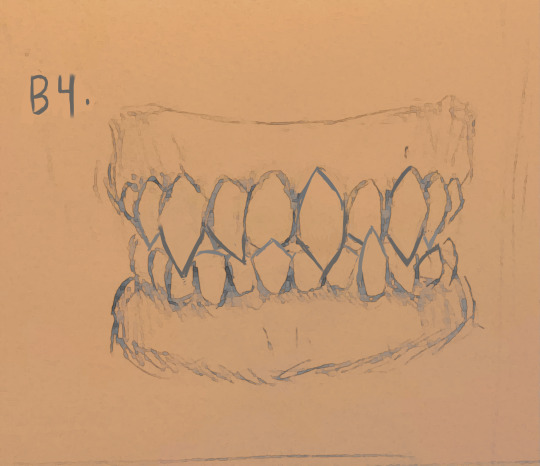
I speak from experience when I say that wouldn't be fun but whatever he deserves the suffering. Enjoy never being able to close your mouth entirely without some amount of discomfort Nimura, you chose this life.
That is all thank you and goodnight apologies for the wait.
#I'm so tired and I didn't even actually do anything this just felt like a lot#Anyways thanks for looking through this mess if anything I should hate all discussion of teeth because things happened#And Yet Here I am. My magnum opus of TG headcanons.#odontophobia#zeph answers questions about media/characters/ships#miscellaneous not-art things#mediocre art#tokyo ghoul#teeth
24 notes
·
View notes
Text
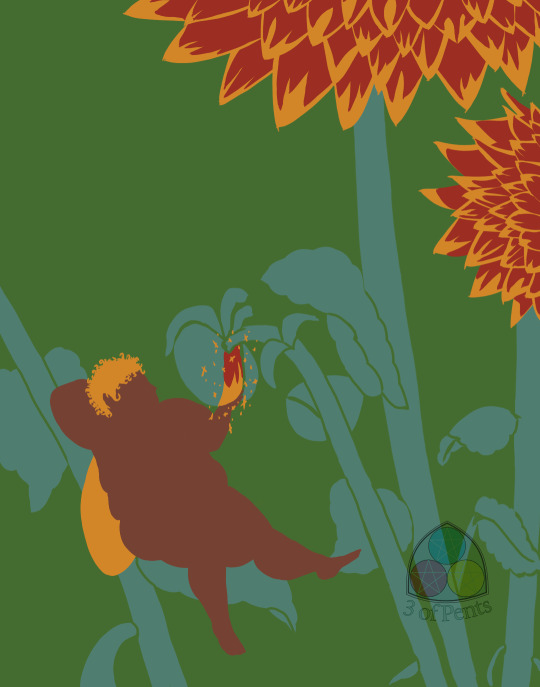
100 Palette Challenge // Palette #10 // Lady Dahlia
I know I'm late again this week. I'm in the midst of a lot of school stuff. I've mentioned, I think, but I've gone back to school to get a graphic design certification. I started last Fall and it was my hope to be done by this summer because the certification programs are designed for adults with careers who want to expand their skill sets and so are pared down to only the classes that are directly relevant to the subject matter. In my case that's only 9 classes, so 3 per semester. But unfortunately I had to withdraw in the Spring because of some health issues. So now I'm trying to pick up where I left off after the school went and changed a bunch of their online systems. So now I get to try and recover my old accounts on their new system and deal with class requirements that don't exist for my program, but apparently exist now for individual classes that are required.
And on top of that we're prepping our toddler to go to daycare, which comes with A LOT of paperwork and supplies lists and doctor signatures and also EMOTIONS.
Anyway.
Today's palette comes from a poster that appears to have been an activist piece of art. I've tried not to go into too much detail here about the posters since the bulk of this book is the palettes and the pieces they were picked from. I'm already posting every single palette in the book, so I'd rather not include the posters also. But I just love this one so much, I have to at least share the information so you can look it up yourselves. It's called "Dig" by Sadie Wendell Mitchell, it's part of a series she did called "Girls Will Be Girls". It depicts a young woman perched on a chair engrossed in a book, and also surrounded by stacks of books. Only a few of the books have visible titles, "The Study of Bugology", "The Psychology of the Male Human", and "Economy" (the one she's reading). And on the wall you can see part of a poster that says "DO IT NOW".
It feels like a very pointed protestation as a poster designed in 1909.
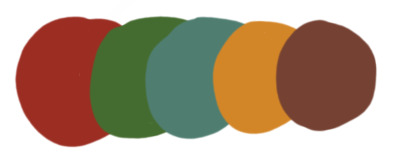
I struggled with this palette a lot. It's not only very similar to a lot of the previous palettes, the values are just so similar, particular with the green and teal. It works fine in the original poster because Mitchell used a heavy black outline, but the author of the book chose not to include that in the palette.
I actually started a completely different piece that going to be a face study, but I just didn't like the way the colors were playing together. So I ended up scrapping it.
So I pulled back a bit. Our dahlias have started blooming and the first ones to pop were these gorgeous red and yellow blooms, and I've wanted to draw a fairy for one of these for several palettes so far, so I did it.
The dahlias were SO much easier and more fun to draw than the peony was. They're so geometric, I really just enjoyed layering the petals and the colors.
I attempted to give the fairy some petal clothes, but it just wasn't doing what I wanted it to do. And I think the form is distinct enough to make her out. I do really like the effect of the teal on the green; the heavy similarities of them both make the fairy and flowers pop more. I do wish I'd filled in some more greenery in the background, but honestly I'd spent so much time on this palette already I didn't have it in me.
I'm really pleased with the final result, though, and I doubt this will be the last fairy piece in this series.
I want to shout out Fat Photo Ref again. I used them for the pose and the hair for the fairy and I remain exceptionally pleased with the range of references available and the easy navigation.
2 notes
·
View notes
Text
In my freshman year of high school (for non-USAmericans this is the first year of HS, when I was about 14-15) my intro to art teacher took out peanuts for all the students, including me, to use as a still life. At the time I wanted to be “strong” so I tried to muscle through being literally surrounded by poison for about 20 minutes. I felt my whole body begin to swell up, and it took a lot of coaxing from both me and my sister (we shared that class) to finally get me to move to another room. I was forced to use a picture of peanuts on my phone as a reference, and I got points taken off for my drawing not using a “proper” reference.
The worst part is?
I did not report the incident at the time because I have previously been shut down and silenced by school staff, and she was in the school system for decades so I knew I couldn’t report her.
Also back in kindergarten my bully found out I had a severe peanut allergy and tried to kill me with his sandwich. After that incident *I* was the one that was isolated for the rest of the year.
And this is not a rare experience. We’re so regularly laughed off and dismissed. I’m still scared to tell restaurant waiters about my allergy out of fear they’ll roll their eyes, and the memes and complaints I’ve seen them post on tumblr about people with food sensitivities make me even more terrified.
I wasn't going to derail the disability pride month post for people with peanut allergies but in relation to that topic
I have never seen another allergy that has been so viscerally hated and mocked by people working in education like nut allergies. I've seen fellow teachers cringe that their classroom was the "nut free" classroom that year. Support staff that are trained and willfully don't follow cross contamination protocol in the lunchroom because it's too "tedious" or "time-consuming". Full preschools + childcare centers that refuse to accommodate nut allergies. Schools where the only free lunch is a PB&J. Before/after school programs and summer programs whose food curriculum has nuts and doesn't provide an alternative activity.
Allergy discrimination is so so insidious and prevalent. It's happening behind their back and it is everything from the exposure joke to possibly causing someone to go into anaphylaxis from willful ignorance.
Also other parents in the classroom are guilty too. The "not my child not my problem" brain rot means that those lunchboxes are like bombs for airborne exposure allergies
42K notes
·
View notes
Text
Sonia Paulino Love Outbound to Montevideo, Day 14
Friday: I met with Irene Müller, art historian and director of Cultural Programs at Uruguay's Goethe Institute, and enjoyed a very engaging conversation about a great many things. Topics included: the opportunity for parody and political criticism with Carnival, the commitment and endurance of Carnival performers, the global age-old fascination with masquerade, approaching a new era of diplomatic strategies, decolonization, systemic racism, the perils of climate change, and the purpose of art in culture / art is culture.
A while later I took a bus out to Prado, an historic neighborhood on the west side of Montevideo, to meet a guid for a 2.5 hour walking tour with temps in the HIGH 90s HOT HOT HOT. We also had engaging conversation about a great many things, while we walked and walked and walked past various monuments and various gardens. Topics included: Shakira, cicadas, his leashed cat, potential faux pas regarding slang for private parts, fast fashion, globalization, Uruguayan exports, and the country's initiatives in legalizing human rights and embracing of diversity. The tour ended with a walk-through of the Blanes Museum exhibits ranging from a large gallery of paintings by the museum's namesake, 19th Century realist painter Juan Manuel Blanes, through to a contemporary show of mixed-media works addressing current social and political issues.
Afterwards, on the bus to the beach to observe "lemanja celebrations" in honor deities of water and nature, I was accosted by a young lady Christian evangelist, and found the encounter ironic and annoying. In answer to her badgering I said that yes I know that [capital G]od loves me because my mami tells me every day. That might have been a bit harsh, making for an awkwardly silent twenty minutes before she got off with a curt “tenga buen dia”.
I came across the stage for performances and speeches for the celebration's 30th Anniversary and, exhausted, stayed from 7-9pm wondering when they were going to take the show down to the beach for all the fanfare I'd heard about. It's not until now, looking stuff up online as I write this, that I've learned I mistook the staged performances for the event and stuff was happening down below at the beach across the highway and la rambla the whole time, and that I pretty much missed the actual Iemanjá for a simulation (insert laugh-cry emoji here).
Saturday: Early start to avoid THE SUN Villa Biarritz Flea Market sparsely attended
Museo Zorrilla Museum from there with a detour through a different mall. Ate a snack bar in the back gardening enjoyed the company of plants.
Had a chat with a woman at the bus stop on the way home for a quick cool off and respite from the harshest time of day. “Aqui no hay nadie!” she said, referring to how quiet it is in town and explained that during the summer people head out to other beach towns on the weekends. My bus finally arrived and she started up with someone else who had shown up.
Back out late afternoon for Castillo Pitamiglio. Bit of a tourist trap. The place is creepy enough as is without the added spooky music soundtrack. I hope he and his mom got along. If you’re one who believes in ghosts, you might still find her in her bedroom.
Sunday: As in New York City, public transportation here is unpredictable on Saturdays and completely unreliable on Sundays. An ordinarily crowded bus was practically empty and so rattly my eyeballs shook.
I spent more time getting to the tournament and back then watching the matches, but, once arrived, the Davis Cup at Lawn Tennis Club in the tawny far-east neighborhood of Carrasco was a pleasure. I know very little about tennis, but even I could tell it was excellent play. It was such a relief to not have to speak or listen, worry about when and how to get to the next event, or be concerned about fatigue or forlornness. The small sections of bleachers were all fully exposed, so another day of THE SUN. Still, it was a pleasant and gratifying experience, very much in the moment, with an occasional passing cloud or ocean breeze that had me almost fall asleep.
Considering the casual bus schedule, chores to do at home in preparation for an overnight trip, and my weekly catch-up meeting with Javier & Valentina, I left before the final match.
0 notes
Text
murderbot uses it/its pronouns, and here’s why
im just sick of seeing people try to be all ‘but its up for interpretation’ ‘it’s ambiguous’ ‘we don’t know’ ‘who can never be sure’ and I saw one of those posts like ‘but an agender/gender-neutral protagonist means I can project whatever i want onto them’ and i have simply had it. essay under the cut. *spoilers* obviously for p much all the books, mostly network effect. there’s 1 quote from FT but it’s not plot-relevant
tl;dr mb refers to itself with it/its pronouns, on top of the quadrillion times it actively rejects human ideas of gender (which is an important theme in the series), on top of its Crew and ART using it/its, on top of Pin-Lee writing it detailed legal contracts using it/its pronouns, on top of that AMA where ART says it and mb use it/its, on top of the blurbs on the inside covers & backs of the books using it/its.
disclaimer: i 100% get people who haven’t done a really close reading of the series using they/them for mb as a ‘i’m not sure what to do’ thing or a ‘given no direction i use they/them until a person expresses a preference’ thing. different people have different amounts of knowledge about pronoun usage and the queer community, and may not have a lot of experience with picking up on a character using nonbinary* pronouns in media. I understand where they’re coming from - most of what I’m talking about it is binarily gendering mb (e.g. he or she gross). although using they/them for murderbot is still misgendering, since mb does demonstrate preference for it/its as early as pg 40 of the first book (see below), it’s still incorrect.
*nonbinary is meant in a very literal sense here, as in “not within the gender binary” i.e. not he/him or she/her. I’m using it as an adjective, not an identity. I’m sure not all it/its users identify as nonbinary, and I highly doubt mb identifies as nonbinary (too much of a human word).
while the series is in first person POV, mb sometimes refers to itself in third person and always uses it/its.
e.g. in Network Effect, when mb is captured by targets near the end and hung upside down and it has to detach its hand to free itself, it remarks, “If this went wrong I was going to feel really stupid. The Targets would finally show up and be all “What the hell was it trying to do to itself?”“ (page 4 of ch 18, my electronic copy doesn’t have individual page #)
update: @chimaerakitten reblogged this with a citation I can’t believe I didn’t include! page 40 of All Systems Red, murderbot drops the iconic line, “Yes, talk to Murderbot about its feelings. The idea was so painful I dropped to 97 percent efficiency.” so there’s not even a “well until network effect-” justification, it’s right there in the beginning baby!
murderbot 2.0 refers to both itself and 1.0 using it/its pronouns.
2.0 is literally a copy of 1.0. it has no reason to misgender itself. there is no room for argument here.
e.g. in Network Effect it remarks “That’s one of the reasons Me 1.0 misses its armor.” (pg 5 of ch 16)
also, it works vice-versa, 1.0 uses it/its for 2.0
e.g. Network Effect “You and Amena were right. 2.0 was a person. It wasn’t like a baby, but it was a person.” (pg 9 of ch 20)
@worldsentwined made a lovely post a while back compiling all of the times mb actively rejects/comments on human gender and sex in relation to itself.
while obvs gender =/= pronouns, it’s important to acknowledge mb’s rejection of human gender, because in the series bot/construct gender is a separate thing - p much all bots use it/its that I noticed.
another thing I realized - obviously, mb not identifying with human gender includes non-binary human genders, of which there are plenty of examples in the series, many of which use they/them (Matteo, Turi, Mihail).
this isn’t to say that using they/them = having a gender, see above re: gender =/= pronouns, but it does help reinforce the point that using they/them for mb is still misgendering.
ART refers to mb with either just “SecUnit” or it/its pronouns.
ART can literally read minds, kind of. you really think they went through all of Artificial Condition and Network Effect together without it picking up on what pronouns mb uses?
e.g. Network Effect, it reassures Amena that mb is going to be just fine - “The damage to its organic tissue and support structure is easily repaired.” (pg 13 of ch 8)
also, you think ART would let any humans onboard it misgender mb? no fuckin way.
e.g. Network Effect
Amena talking to ART in private “- because it thought you were dead. It was so upset I thought-Oh, hey, you’re here” (pg 21 of ch 12)
when mb 1.0 finally gets back aboard ART and collapses on the deck - “Amena’s voice said “No, it doesn’t like to be touched!”“ (pg 1 of ch 20)
the PresAux gang use it/its
You could probably try to be like ‘well maybe the presaux gang is just using the secunit standard pronoun’ but consider: by exit strategy, mb has few to no reservations about correcting people, especially people it knows, when they’re wrong.
also Pin-Lee negotiated a contract for it hammering out every detail of interaction, including the “no hugging” clause - she would ABSOLUTELY include whatever pronoun use mb wanted.
e.g. Network Effect, ““No, it says it’s fine,” I heard her [Overse] relaying to the others on our comm. “Well, yes, it’s furious,””(pg 6 (of ch 1))
e.g. Fugitive Telemetry, ““It’s joking.” Ratthi managed to sound like he completely believed that. “That’s how it looks when it’s joking.”“ (pg 15 of ch 4)
Martha Wells did an instagram AMA as mb and ART and upon being asked what pronouns mb and ART use, ART responded w “it/its”
now obvs there’s a bajillion ways that you could tear this apart and argue death of the author, or that bc ART answered not mb it was different, but frankly my dear i don’t give a damn. it’s supporting evidence, not the lynchpin of the whole argument.
update: I finally got Artificial Condition in hardcover, and noticed the little summary blurb on the inside jacket flap thing makes liberal use of the it/its pronoun
“It has a dark past…a past that caused it to christen itself Murderbot. But it has only vague memories of the massacre that spawned that title, and it wants to know more.”
“Murderbot heads to the mining facility where it went rogue. What it discovers will forever change the way it thinks…”
in rogue protocol when mb pretends to be a human security consultant the (fictional) off-base supervisor it makes up is called by she/her once or twice, but note that that’s when mb is pretending to be human, and not even that really since the offsite “security consultant Rin” is 100% fabricated. it/its is kind of the bot pronoun - mb uses it as a way to remind everyone that it’s not human and doesn’t want to be and that’s important and also another post in itself.
but basically: a main theme of the series is acceptance of bots and constructs and non-human entities as people worthy of respect, discrete from humans, and that mb doesn’t have to become human/make itself palatable for humans to be seen as a person, and the it/its pronoun use is an important part of that.
that’s all i got for now but when I get physical copies of the rest of the series its over baby, citations all day every day. I have electronic copies of NE and FT and ASR and physical AC and ES copies, the rest I got from the library to read and thus do not have atm. feel free to add citations in reblogs!
update: i saw a post that brought up an interesting and valid point I want to address (when I find it again I’ll link it) - as a they/them person who isn’t out everywhere, oftentimes I am misgendered and I don’t correct them because its easier - the OP mentioned experiencing the same phenomenon, and I can totally see how this applies to murderbot. If it was just everyone around it using it/its pronouns and it not objecting, that’d be a different story, and I would totally agree with the ambiguity. however, mb does use it/its for itself, and even though it’s not turning to the camera and saying ‘I use it/its’, that still expresses a preference which should be respected.
maybe mb will go by different pronouns in the future as it reckons with and thinks about its own personhood, but I kind of hope not. partly because there are people out there who do use it/its, and I can’t imagine the lack of representation they must face, but also because I think recognition of personhood outside of the human world is an important theme (allegorical to marginalized groups who want to be seen as people without conforming to every widely accepted societal ideal of personhood) (I may be projecting as an autistic person who wants acceptance).
this got too deep and too long. sorry, i just have a lot of feelings.
#murderbot#murderbot spoilers#network effect#network effect spoilers#fugitive telemetry#fugitive telemetry spoilers#meta#pronouns#my Opinions#original post
592 notes
·
View notes
Text
Anonymous asked: I enjoyed reading your posts about Napoleon’s death and it’s quite timely given its the 200th anniversary of his death this year in May. I was wondering, because you know a lot about military history (your served right? That’s cool to fly combat helicopters) and you live in France but aren’t French, what your take was on Napoleon and how do the French view him? Do they hail him as a hero or do they like others see him like a Hitler or a Stalin? Do you see him as a hero or a villain of history?
5 May 1821 was a memorable date because Napoleon, one of the most iconic figures in world history, died while in bitter exile on a remote island in the South Atlantic Ocean. Napoleon Bonaparte, as you know rose from obscure soldier to a kind of new Caesar, and yet he remains a uniquely controversial figure to this day especially in France. You raise interesting questions about Napoleon and his legacy. If I may reframe your questions in another way. Should we think of him as a flawed but essentially heroic visionary who changed Europe for the better? Or was he simply a military dictator, whose cult of personality and lust for power set a template for the likes of Hitler?
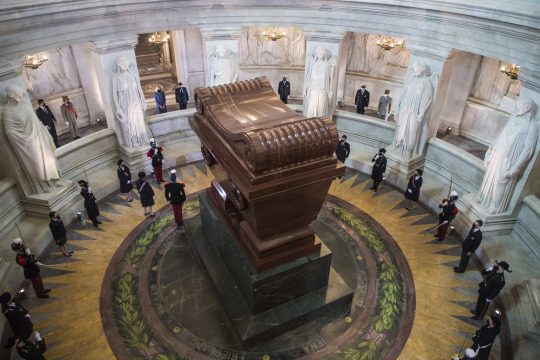
However one chooses to answer this question can we just - to get this out of the way - simply and definitively say that Napoleon was not Hitler. Not even close. No offence intended to you but this is just dumb ahistorical thinking and it’s a lazy lie. This comparison was made by some in the horrid aftermath of the Second World War but only held little currency for only a short time thereafter. Obviously that view didn’t exist before Hitler in the 19th Century and these days I don’t know any serious historian who takes that comparison seriously.
I confess I don’t have a definitive answer if he was a hero or a villain one way or the other because Napoleon has really left a very complicated legacy. It really depends on where you’re coming from.
As a staunch Brit I do take pride in Britain’s victorious war against Napoleonic France - and in a good natured way rubbing it in the noses of French friends at every opportunity I get because it’s in our cultural DNA and it’s bloody good fun (why else would we make Waterloo train station the London terminus of the Eurostar international rail service from its opening in 1994? Or why hang a huge gilded portrait of the Duke of Wellington as the first thing that greets any visitor to the residence of the British ambassador at the British Embassy?). On a personal level I take special pride in knowing my family ancestors did their bit on the battlefield to fight against Napoleon during those tumultuous times. However, as an ex-combat veteran who studied Napoleonic warfare with fan girl enthusiasm, I have huge respect for Napoleon as a brilliant military commander. And to makes things more weird, as a Francophile resident of who loves living and working in France (and my partner is French) I have a grudging but growing regard for Napoleon’s political and cultural legacy, especially when I consider the current dross of political mediocrity on both the political left and the right. So for me it’s a complicated issue how I feel about Napoleon, the man, the soldier, and the political leader.

If it’s not so straightforward for me to answer the for/against Napoleon question then it It’s especially true for the French, who even after 200 years, still have fiercely divided opinions about Napoleon and his legacy - but intriguingly, not always in clear cut ways.
I only have to think about my French neighbours in my apartment building to see how divisive Napoleon the man and his legacy is. Over the past year or so of the Covid lockdown we’ve all gotten to know each other better and we help each other. Over the Covid year we’ve gathered in the inner courtyard for a buffet and just lifted each other spirits up.
One of my neighbours, a crusty old ex-general in the army who has an enviable collection of military history books that I steal, liberate, borrow, often discuss military figures in history like Napoleon over our regular games of chess and a glass of wine. He is from very old aristocracy of the ancien regime and whose family suffered at the hands of ‘madame guillotine’ during the French Revolution. They lost everything. He has mixed emotions about Napoleon himself as an old fashioned monarchist. As a military man he naturally admires the man and the military genius but he despises the secularisation that the French Revolution ushered in as well as the rise of the haute bourgeois as middle managers and bureaucrats by the displacement of the aristocracy.
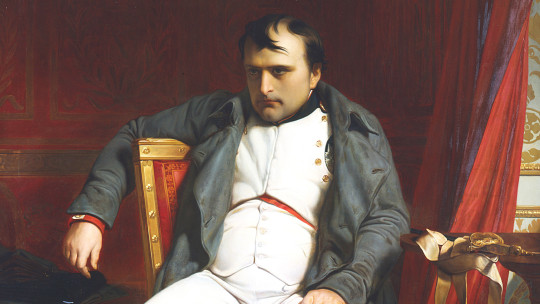
Another retired widowed neighbour I am close to, and with whom I cook with often and discuss art, is an active arts patron and ex-art gallery owner from a very wealthy family that came from the new Napoleonic aristocracy - ie the aristocracy of the Napoleonic era that Napoleon put in place - but she is dismissive of such titles and baubles. She’s a staunch Republican but is happy to concede she is grateful for Napoleon in bringing order out of chaos. She recognises her own ambivalence when she says she dislikes him for reintroducing slavery in the French colonies but also praises him for firmly supporting Paris’s famed Comédie-Française of which she was a past patron.
Another French neighbour, a senior civil servant in the Elysée, is quite dismissive of Napoleon as a war monger but is grudgingly grateful for civil institutions and schools that Napoleon established and which remain in place today.
My other neighbours - whether they be French families or foreign expats like myself - have similarly divisive and complicated attitudes towards Napoleon.

In 2010 an opinion poll in France asked who was the most important man in French history. Napoleon came second, behind General Charles de Gaulle, who led France from exile during the German occupation in World War II and served as a postwar president.
The split in French opinion is closely mirrored in political circles. The divide is generally down political party lines. On the left, there's the 'black legend' of Bonaparte as an ogre. On the right, there is the 'golden legend' of a strong leader who created durable institutions.
Jacques-Olivier Boudon, a history professor at Paris-Sorbonne University and president of the Napoléon Institute, once explained at a talk I attended that French public opinion has always remained deeply divided over Napoleon, with, on the one hand, those who admire the great man, the conqueror, the military leader and, on the other, those who see him as a bloodthirsty tyrant, the gravedigger of the revolution. Politicians in France, Boudon observed, rarely refer to Napoleon for fear of being accused of authoritarian temptations, or not being good Republicans.

On the left-wing of French politics, former prime minister Lionel Jospin penned a controversial best selling book entitled “the Napoleonic Evil” in which he accused the emperor of “perverting the ideas of the Revolution” and imposing “a form of extreme domination”, “despotism” and “a police state” on the French people. He wrote Napoleon was "an obvious failure" - bad for France and the rest of Europe. When he was booted out into final exile, France was isolated, beaten, occupied, dominated, hated and smaller than before. What's more, Napoleon smothered the forces of emancipation awakened by the French and American revolutions and enabled the survival and restoration of monarchies. Some of the legacies with which Napoleon is credited, including the Civil Code, the comprehensive legal system replacing a hodgepodge of feudal laws, were proposed during the revolution, Jospin argued, though he acknowledges that Napoleon actually delivered them, but up to a point, "He guaranteed some principles of the revolution and, at the same time, changed its course, finished it and betrayed it," For instance, Napoleon reintroduced slavery in French colonies, revived a system that allowed the rich to dodge conscription in the military and did nothing to advance gender equality.
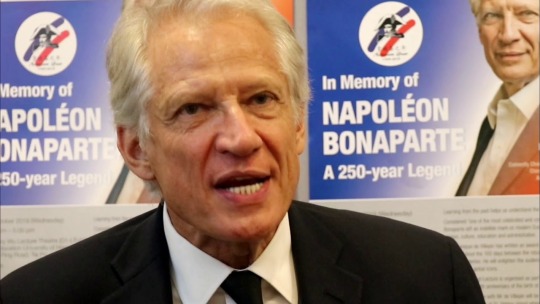
At the other end of the spectrum have been former right-wing prime minister Dominique de Villepin, an aristocrat who was once fancied as a future President, a passionate collector of Napoleonic memorabilia, and author of several works on the subject. As a Napoleonic enthusiast he tells a different story. Napoleon was a saviour of France. If there had been no Napoleon, the Republic would not have survived. Advocates like de Villepin point to Napoleon’s undoubted achievements: the Civil Code, the Council of State, the Bank of France, the National Audit office, a centralised and coherent administrative system, lycées, universities, centres of advanced learning known as école normale, chambers of commerce, the metric system, and an honours system based on merit (which France has to this day). He restored the Catholic faith as the state faith but allowed for the freedom of religion for other faiths including Protestantism and Judaism. These were ambitions unachieved during the chaos of the revolution. As it is, these Napoleonic institutions continue to function and underpin French society. Indeed, many were copied in countries conquered by Napoleon, such as Italy, Germany and Poland, and laid the foundations for the modern state.
Back in 2014, French politicians and institutions in particular were nervous in marking the 200th anniversary of Napoleon's exile. My neighbours and other French friends remember that the commemorations centred around the Chateau de Fontainebleau, the traditional home of the kings of France and was the scene where Napoleon said farewell to the Old Guard in the "White Horse Courtyard" (la cour du Cheval Blanc) at the Palace of Fontainebleau. (The courtyard has since been renamed the "Courtyard of Goodbyes".) By all accounts the occasion was very moving. The 1814 Treaty of Fontainebleau stripped Napoleon of his powers (but not his title as Emperor of the French) and sent him into exile on Elba. The cost of the Fontainebleau "farewell" and scores of related events over those three weekends was shouldered not by the central government in Paris but by the local château, a historic monument and UNESCO World Heritage site, and the town of Fontainebleau.
While the 200th anniversary of the French Revolution that toppled the monarchy and delivered thousands to death by guillotine was officially celebrated in 1989, Napoleonic anniversaries are neither officially marked nor celebrated. For example, over a decade ago, the president and prime minister - at the time, Jacques Chirac and Dominque de Villepin - boycotted a ceremony marking the 200th anniversary of the battle of Austerlitz, Napoleon's greatest military victory. Both men were known admirers of Napoleon and yet political calculation and optics (as media spin doctors say) stopped them from fully honouring Napoleon’s crowning military glory.
Optics is everything. The division of opinion in France is perhaps best reflected in the fact that, in a city not shy of naming squares and streets after historical figures, there is not a single “Boulevard Napoleon” or “Place Napoleon” in Paris. On the streets of Paris, there are just two statues of Napoleon. One stands beneath the clock tower at Les Invalides (a military hospital), the other atop a column in the Place Vendôme. Napoleon's red marble tomb, in a crypt under the Invalides dome, is magnificent, perhaps because his remains were interred there during France's Second Empire, when his nephew, Napoleon III, was on the throne.

There are no squares, nor places, nor boulevards named for Napoleon but as far as I know there is one narrow street, the rue Bonaparte, running from the Luxembourg Gardens to the River Seine in the old Latin Quarter. And, that, too, is thanks to Napoleon III. For many, and I include myself, it’s a poor return by the city to the man who commissioned some of its most famous monuments, including the Arc de Triomphe and the Pont des Arts over the River Seine.
It's almost as if Napoleon Bonaparte is not part of the national story.
How Napoleon fits into that national story is something historians, French and non-French, have been grappling with ever since Napoleon died. The plain fact is Napoleon divides historians, what precisely he represents is deeply ambiguous and his political character is the subject of heated controversy. It’s hard for historians to sift through archival documents to make informed judgements and still struggle to separate the man from the myth.
One proof of this myth is in his immortality. After Hitler’s death, there was mostly an embarrassed silence; after Stalin’s, little but denunciation. But when Napoleon died on St Helena in 1821, much of Europe and the Americas could not help thinking of itself as a post-Napoleonic generation. His presence haunts the pages of Stendhal and Alfred de Vigny. In a striking and prescient phrase, Chateaubriand prophesied the “despotism of his memory”, a despotism of the fantastical that in many ways made Romanticism possible and that continues to this day.
The raw material for the future Napoleon myth was provided by one of his St Helena confidants, the Comte de las Cases, whose account of conversations with the great man came out shortly after his death and ran in repeated editions throughout the century. De las Cases somehow metamorphosed the erstwhile dictator into a herald of liberty, the emperor into a slayer of dynasties rather than the founder of his own. To the “great man” school of history Napoleon was grist to their mill, and his meteoric rise redefined the meaning of heroism in the modern world.
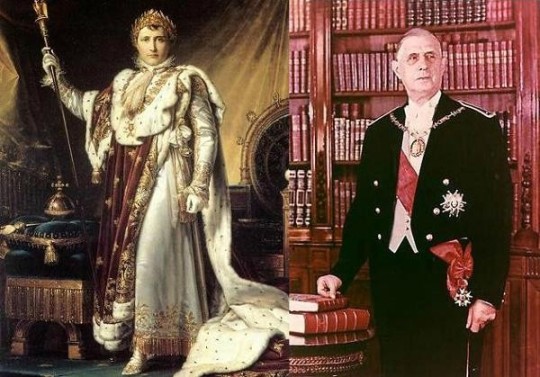
The Marxists, for all their dislike of great men, grappled endlessly with the meaning of the 18th Brumaire; indeed one of France’s most eminent Marxist historians, George Lefebvre, wrote what arguably remains the finest of all biographies of him.
It was on this already vast Napoleon literature, a rich terrain for the scholar of ideas, that the great Dutch historian Pieter Geyl was lecturing in 1940 when he was arrested and sent to Buchenwald. There he composed what became one of the classics of historiography, a seminal book entitled Napoleon: For and Against, which charted how generations of intellectuals had happily served up one Napoleon after another. Like those poor souls who crowded the lunatic asylums of mid-19th century France convinced that they were Napoleon, generations of historians and novelists simply could not get him out of their head.
The debate runs on today no less intensely than in the past. Post-Second World War Marxists would argue that he was not, in fact, revolutionary at all. Eric Hobsbawm, a notable British Marxist historian, argued that ‘Most-perhaps all- of his ideas were anticipated by the Revolution’ and that Napoleon’s sole legacy was to twist the ideals of the French Revolution, and make them ‘more conservative, hierarchical and authoritarian’.
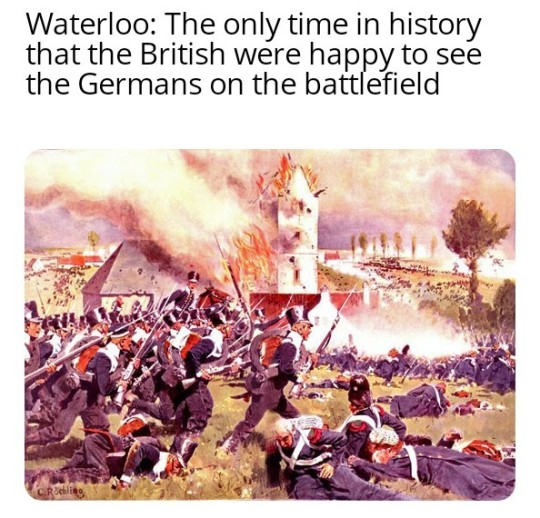
This contrasts deeply with the view William Doyle holds of Napoleon. Doyle described Bonaparte as ‘the Revolution incarnate’ and saw Bonaparte’s humbling of Europe’s other powers, the ‘Ancien Regimes’, as a necessary precondition for the birth of the modern world. Whatever one thinks of Napoleon’s character, his sharp intellect is difficult to deny. Even Paul Schroeder, one of Napoleon’s most scathing critics, who condemned his conduct of foreign policy as a ‘criminal enterprise’ never denied Napoleon’s intellect. Schroder concluded that Bonaparte ‘had an extraordinary capacity for planning, decision making, memory, work, mastery of detail and leadership’. The question of whether Napoleon used his genius for the betterment or the detriment of the world, is the heart of the debate which surrounds him.
France's foremost Napoleonic scholar, Jean Tulard, put forward the thesis that Bonaparte was the architect of modern France. "And I would say also pâtissier [a cake and pastry maker] because of the administrative millefeuille that we inherited." Oddly enough, in North America the multilayered mille-feuille cake is called ‘a napoleon.’ Tulard’s works are essential reading of how French historians have come to tackle the question of Napoleon’s legacy. He takes the view that if Napoleon had not crushed a Royalist rebellion and seized power in 1799, the French monarchy and feudalism would have returned, Tulard has written. "Like Cincinnatus in ancient Rome, Napoleon wanted a dictatorship of public salvation. He gets all the power, and, when the project is finished, he returns to his plough." In the event, the old order was never restored in France. When Louis XVIII became emperor in 1814, he served as a constitutional monarch.
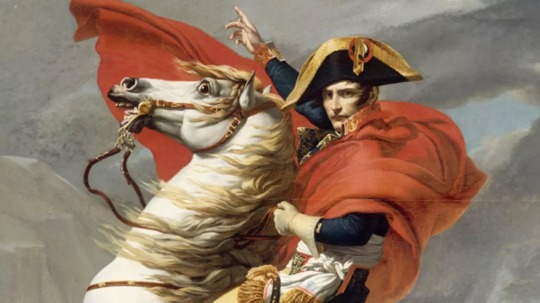
In England, until recently the views on Napoleon have traditionally less charitable and more cynical. Professor Christopher Clark, the notable Cambridge University European historian, has written. "Napoleon was not a French patriot - he was first a Corsican and later an imperial figure, a journey in which he bypassed any deep affiliation with the French nation," Clark believed Napoleon’s relationship with the French Revolution is deeply ambivalent.
Did he stabilise the revolutionary state or shut it down mercilessly? Clark believes Napoleon seems to have done both. Napoleon rejected democracy, he suffocated the representative dimension of politics, and he created a culture of courtly display. A month before crowning himself emperor, Napoleon sought approval for establishing an empire from the French in a plebiscite; 3,572,329 voted in favour, 2,567 against. If that landslide resembles an election in North Korea, well, this was no secret ballot. Each ‘yes’ or ‘no’ was recorded, along with the name and address of the voter. Evidently, an overwhelming majority knew which side their baguette was buttered on.
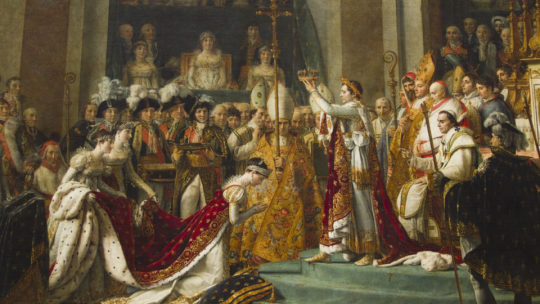
His extravagant coronation in Notre Dame in December 1804 cost 8.5 million francs (€6.5 million or $8.5 million in today's money). He made his brothers, sisters and stepchildren kings, queens, princes and princesses and created a Napoleonic aristocracy numbering 3,500. By any measure, it was a bizarre progression for someone often described as ‘a child of the Revolution.’ By crowning himself emperor, the genuine European kings who surrounded him were not convinced. Always a warrior first, he tried to represent himself as a Caesar, and he wears a Roman toga on the bas-reliefs in his tomb. His coronation crown, a laurel wreath made of gold, sent the same message. His icon, the eagle, was also borrowed from Rome. But Caesar's legitimacy depended on military victories. Ultimately, Napoleon suffered too many defeats.
These days Napoleon the man and his times remain very much in fashion and we are living through something of a new golden age of Napoleonic literature. Those historians who over the past decade or so have had fun denouncing him as the first totalitarian dictator seem to have it all wrong: no angel, to be sure, he ended up doing far more at far less cost than any modern despot. In his widely praised 2014 biography, Napoleon the Great, Andrew Roberts writes: “The ideas that underpin our modern world - meritocracy, equality before the law, property rights, religious toleration, modern secular education, sound finances, and so on - were championed, consolidated, codified and geographically extended by Napoleon. To them he added a rational and efficient local administration, an end to rural banditry, the encouragement of science and the arts, the abolition of feudalism and the greatest codification of laws since the fall of the Roman empire.”
Roberts partly bases his historical judgement on newly released historical documents about Napoleon that were only available in the past decade and has proved to be a boon for all Napoleonic scholars. Newly released 33,000 letters Napoleon wrote that still survive are now used extensively to illustrate the astonishing capacity that Napoleon had for compartmentalising his mind - he laid down the rules for a girls’ boarding school on the eve of the battle of Borodino, for example, and the regulations for Paris’s Comédie-Française while camped in the Kremlin. They also show Napoleon’s extraordinary capacity for micromanaging his empire: he would write to the prefect of Genoa telling him not to allow his mistress into his box at the theatre, and to a corporal of the 13th Line regiment warning him not to drink so much.
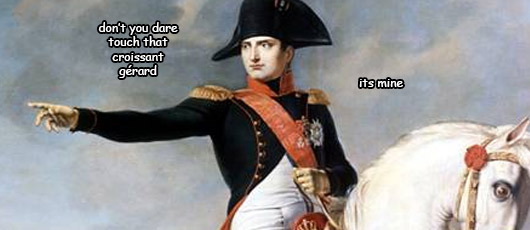
For me to have my own perspective on Napoleon is tough. The problem is that nothing with Napoleon is simple, and almost every aspect of his personality is a maddening paradox. He was a military genius who led disastrous campaigns. He was a liberal progressive who reinstated slavery in the French colonies. And take the French Revolution, which came just before Napoleon’s rise to power, his relationship with the French Revolution is deeply ambivalent. Did he stabilise it or shut it down? I agree with those British and French historians who now believe Napoleon seems to have done both.
On the one hand, Napoleon did bring order to a nation that had been drenched in blood in the years after the Revolution. The French people had endured the crackdown known as the 'Reign of Terror', which saw so many marched to the guillotine, as well as political instability, corruption, riots and general violence. Napoleon’s iron will managed to calm the chaos. But he also rubbished some of the core principles of the Revolution. A nation which had boldly brought down the monarchy had to watch as Napoleon crowned himself Emperor, with more power and pageantry than Louis XVI ever had. He also installed his relatives as royals across Europe, creating a new aristocracy. In the words of French politician and author Lionel Jospin, 'He guaranteed some principles of the Revolution and at the same time, changed its course, finished it and betrayed it.'

He also had a feared henchman in the form of Joseph Fouché, who ran a secret police network which instilled dread in the population. Napoleon’s spies were everywhere, stifling political opposition. Dozens of newspapers were suppressed or shut down. Books had to be submitted for approval to the Commission of Revision, which sounds like something straight out of George Orwell. Some would argue Hitler and Stalin followed this playbook perfectly. But here come the contradictions. Napoleon also championed education for all, founding a network of schools. He championed the rights of the Jews. In the territories conquered by Napoleon, laws which kept Jews cooped up in ghettos were abolished. 'I will never accept any proposals that will obligate the Jewish people to leave France,' he once said, 'because to me the Jews are the same as any other citizen in our country.'
He also, crucially, developed the Napoleonic Code, a set of laws which replaced the messy, outdated feudal laws that had been used before. The Napoleonic Code clearly laid out civil laws and due processes, establishing a society based on merit and hard work, rather than privilege. It was rolled out far beyond France, and indisputably helped to modernise Europe. While it certainly had its flaws – women were ignored by its reforms, and were essentially regarded as the property of men – the Napoleonic Code is often brandished as the key evidence for Napoleon’s progressive credentials. In the words of historian Andrew Roberts, author of Napoleon the Great, 'the ideas that underpin our modern world… were championed by Napoleon'.
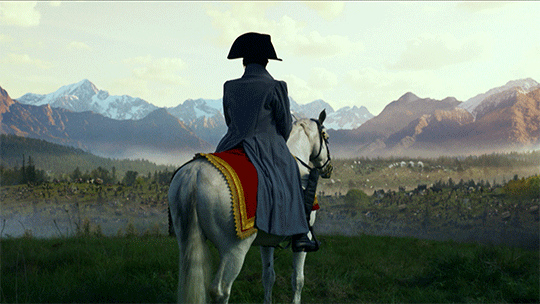
What about Napoleon’s battlefield exploits? If anything earns comparisons with Hitler, it’s Bonaparte’s apparent appetite for conquest. His forces tore down republics across Europe, and plundered works of art, much like the Nazis would later do. A rampant imperialist, Napoleon gleefully grabbed some of the greatest masterpieces of the Renaissance, and allegedly boasted, 'the whole of Rome is in Paris.'
Napoleon has long enjoyed a stellar reputation as a field commander – his capacities as a military strategist, his ability to read a battle, the painstaking detail with which he made sure that he cold muster a larger force than his adversary or took maximum advantage of the lie of the land – these are stuff of the military legend that has built up around him. It is not without its critics, of course, especially among those who have worked intensively on the later imperial campaigns, in the Peninsula, in Russia, or in the final days of the Empire at Waterloo.
Doubts about his judgment, and allegations of rashness, have been raised in the context of some of his victories, too, most notably, perhaps, at Marengo. But overall his reputation remains largely intact, and his military campaigns have been taught in the curricula of military academies from Saint-Cyr to Sandhurst, alongside such great tacticians as Alexander the Great and Hannibal.
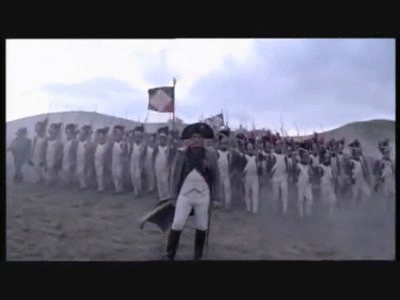
Historians may query his own immodest opinion that his presence on the battlefield was worth an extra forty thousand men to his cause, but it is clear that when he was not present (as he was not for most of the campaign in Spain) the French were wont to struggle. Napoleon understood the value of speed and surprise, but also of structures and loyalties. He reformed the army by introducing the corps system, and he understood military aspirations, rewarding his men with medals and honours; all of which helped ensure that he commanded exceptional levels of personal loyalty from his troops.
Yet, I do find it hard to side with the more staunch defenders of Napoleon who say his reputation as a war monger is to some extent due to British propaganda at the time. They will point out that the Napoleonic Wars, far from being Napoleon’s fault, were just a continuation of previous conflicts that arose thanks to the French Revolution. Napoleon, according to this analysis, inherited a messy situation, and his only real crime was to be very good at defeating enemies on the battlefield. I think that is really pushing things too far. I mean deciding to invade Spain and then Russia were his decisions to invade and conquer.
He was, by any measure, a genius of war. Even his nemesis the Duke of Wellington, when asked who the greatest general of his time was, replied: 'In this age, in past ages, in any age, Napoleon.'
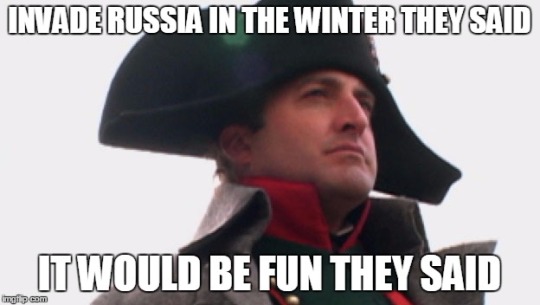
I will qualify all this and agree that Napoleon’s Russian campaign has been rightly held up as a fatal folly which killed so many of his men, but this blunder – epic as it was – should not be compared to Hitler’s wars of evil aggression. Most historians will agree that comparing the two men is horribly flattering to Hitler - a man fuelled by visceral, genocidal hate - and demeaning to Napoleon, who was a product of Enlightenment thinking and left a legacy that in many ways improved Europe.
Napoleon was, of course, no libertarian, and no pluralist. He would tolerate no opposition to his rule, and though it was politicians and civilians who imposed his reforms, the army was never far behind. But comparisons with twentieth-century dictators are well wide of the mark. While he insisted on obedience from those he administered, his ideology was based not on division or hatred, but on administrative efficiency and submission to the law. And the state he believed in remained stubbornly secular.
In Catholic southern Europe, of course, that was not an approach with which it was easy to acquiesce; and disorder, insurgency and partisan attacks can all be counted among the results. But these were principles on which the Emperor would not and could not give ground. If he had beliefs they were not religious or spiritual beliefs, but the secular creed of a man who never forgot that he owed both his military career and his meteoric political rise to the French Revolution, and who never quite abandoned, amidst the monarchical symbolism and the court pomp of the Empire, the republican dreams of his youth. When he claimed, somewhat ambiguously, after the coup of 18 Brumaire that `the Revolution was over’, he almost certainly meant that the principles of 1789 had at last been consummated, and that the continuous cycle of violence of the 1790s could therefore come to an end.
When the Empire was declared in 1804, the wording, again, might seem curious, the French being informed that the `Republic would henceforth be ruled by an Emperor’. Napoleon might be a dictator, but a part at least of him remained a son of the Enlightenment.
The arguments over Napoleon’s status will continue - and that in itself is a testament to the power of one of the most complex figures ever to straddle the world’s stage.
Will the fascination with Napoleon continue for another 200 years?
In France, at least, enthusiasm looks set to diminish. Napoleon and his exploits are scarcely mentioned in French schools anymore. Stéphane Guégan, curator of the Musée d'Orsay in Paris, which, among other First Empire artworks, houses a plaster model of Napoleon dressed as a Roman emperor astride a horse, has described France's fascination with him as ‘a national illness.’ He believes that the people who met him were fascinated by his charm. And today, even the most hostile to Napoleon also face this charm. So there is a difficulty to apprehend the duality of this character. As he wrote, “He was born from the revolution, he extended and finished it, and after 1804 he turns into a despot, a dictator.”
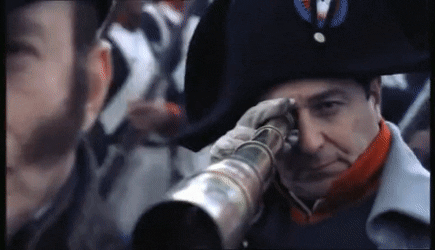
In France, Guégan aptly observes, there is a kind of nostalgia, not for dictatorship but for strong leaders. "Our age is suffering a lack of imagination and political utopia,"
Here I think Guégan is onto something. Napoleon’s stock has always risen or fallen according to the vicissitudes of world events and fortunes of France itself.
In the past, history was the study of great men and women. Today the focus of teaching is on trends, issues and movements. France in 1800 is no longer about Louis XVI and Napoleon Bonaparte. It's about the industrial revolution. Man does not make history. History makes men. Or does it? The study of history makes a mug out of those with such simple ideological driven conceits.
For two hundred years on, the French still cannot agree on whether Napoleon was a hero or a villain as he has swung like a pendulum according to the gravitational pull of historical events and forces.
The question I keep asking of myself and also to French friends with whom I discuss such things is what kind of Napoleon does our generation need?
Thanks for your question.
#question#ask#napoleon#french#french history#history#military history#bonaparte#france#historiography#republic#historians#personal
417 notes
·
View notes
Text
yknow. really living up to the "thoughts that come to mind" portion of the bio
I gotta organize my thoughts on some stuff more often.
anyway on the note of MGS1 being on my head. I feel like there is a certain romanticism for PS1 era games, that while I do get, often makes discussion of games of this era a pain in the ass.
3D was finally more accessible which lead to a huge wave experiments... and god some experiments had some ROUGH edges.
MGS is a groundbreaking title, even years later its scope and execution on the hardware is absolutely insane. The voice actor cast, the art direction, expansion of gameplay systems from previous games, the ambitious narrative, atmospheric and smart stage design. Its a resounding success for the new dimension.
I want to make it clear that im not trying bring down the work that went into MGS1 and how much of an achievement it is and how its successes hold up and have been utilized as reference time and time again for even more creative works since.
BUT... can we also include in the discussion the aspects that dont quite work and could be improved upon?
Gun play is a little limited which leads to moments where precise aim is frustrating (and generally affects the flow of combat), movement feels a tad off (Particularly when you have to move foward slightly, like tapping the dpad. snake has a bit of a small period where he doesnt quite move foward when you press the analog stick or dpad. its wierd to describe but it has actively annoyed me every time I arrive at the laser trap...)
Im not expecting those kinks to not be present, my god id be scared if they weren't there considering its on the PS1, but im tired of discussion often shoving these things under the rug.
I remember feeling like this when going through OOT a few years ago. I loved it! It was such a wonderful adventure and I truly got to experience what so many people saw in the game! Why it was often called one of, if not, the best game of all time!
...
but at the same time control has issues! some stuff is funky with geometry! some design decisions are questionable and some of the menuing can be seen as aggravating! acting like the game is lacking in flaws all this time later is... silly!
Why is it such a constant thing to try to avoid talking flaws in games... yknow what no, I do get it.
Im not exempt from this and I will fully admit it, there is a drive to present the media we love in the best possible light as to draw in more people to it, to share a wonderful experience with others but with that, there is a fear that presenting negatives will stop others from giving things a fair shake
To truly appreciate media its worth noting what works and what doesn't within the vision of the creatives behind it.
I wish people said that some things sucked but they didnt stop an experience from being enjoyable...
I cannot blame people for avoiding those things. I cant blame some for being deeply in love with the media they consumed when they were younger. clinging to a perfect memory of a flawless gem; it can be reassuring sometimesand I dont blame anyone for doing so...
Its all love and people wanting others to see what they got to see, even if that can be an impossibility
I get it but its frustrating. Gotta keep it real, man.
Man I forgot how much I hated ocelot in MGS1
1 note
·
View note
Note
I keep seeing things about how the blog everythingfox is bad. But I'm not sure why. Do you know?
I suspect: "it's complicated". As with so many of these things, especially on tumblr, the given reasons are of uncertain significance, and uncertain veracity.
What I've heard are claims of:
-Posting content without credit/references. If that's the case, not great, but also that's so common at this point it's almost a norm of how this kind of blogging works. As an artist I of course find uncredited art very distasteful, but I don't know if that's what everythingfox posts. Sharing memes or photos that aren't art and aren't related to someones's livelyhood feels like such a low level problem that I'm not really going to engage with it, however I also do my best to credit.
-Posting content in which foxes are not being treated well, eg, foxes kept as pets, maybe other things. This is related to the Is The Animal Video Cute kind of blogs. I'm very mixed on this. A really significant amount of fox media of all kinds is problematic. Should foxes be kept as pets? Probably not, but some are rescues. Running a fox blog will almost inevitably include a large amount of not ideal content, it's very good to try to be ethical, and the Is The Video Cute blogs are probably doing a good service by informing people. But also, most blogs including everythingfox and I don't own or encounter foxes, so they are not themselves mistreating a fox, even if it makes the content less cute or less ethical to produce. So maybe this comes down something like "does this content encourage unethical treatment of animals", to which the answer is probably no, as very few people could legally or practically own a fox. Except of course, if anyone finds it IS relevant to them: don't feed wild foxes, and only keep wild animals as pets if they are a rescue and if after doing significant research you find you are able to do the hard work of caring for them.
I'm sure lots of my posting falls into this category: it would be better for wildlife if people never interacted with them, however it's complicated and very hard to say what is a genuine rescue animal, etc, so I just try to keep it reasonable.
-Finally, the part that I find least convincing: apparently everythingfox has been called out for their content and ignored it. It is possible there are specific valid examples. However, there are too many problems with this idea for me to credit it more broadly. First, big blogs get a lot of notes so they have absolutely no way to know if someone has tried to communicate with them: my blog is much smaller and I get thousands of notes a day. That's exacerbated by secondly: tumblr is garbage software. Most forms of communication here are broken, I don't recieve asks, replies, reblogs, or messages properly. So often someone won't know if they have been called out for something. Finally, if somone does recieve a Call Out, whether or not the premise is valid, these often come across as a person you don't know telling you to die for reasons they may or may not articulate. Maybe there have been well made points, based on well supported notions of poor treatment of animals, clearly and reasonably delivered, that somehow made it through tumblr's awful systems. Most of the time however, I suspect at least one of these problems will get in the way.
tl;dr
It's very good for people to try to be as ethical as they can. It's good to help others do that, and the Is The Post Cute kind of blogs are probably doing a good job. However this entire paradigm (tumblr, twitter, etc) of blogging is a mess, everythingfox probably doesn't own a fox and probably isn't directly influencing fox owners. Their content could probably be better. I try not to engage in Is This Person Bad (*on these issues specifically) because this is the disaster site and everything is has multiple sides.
Anyway, I thought I should reply since I was asked. I know I've said it but I must make it clear again: there is probably stuff I don't know. This is the general vibe from the fair bit of discourse I've seen.
(*I'm a big fan of Callout Culture, except to note that it barely exists. When racist conservatives, predatory men in the film industry, authors of popular children's stories who decide to become vile bigots, etc, complain of Callout Culture, what they are upset about is finally recieving a tiny amount of the much greater social justice they have earned. It's important that these are better documented issues with more clearly harmful outcomes perpetrated by specifically identified people/organisations and, crucially, their actions and the response to them are not conducted entirely on a barely functional website)
#i wonder if I've said anything that will get me cancelled#long post#words#not a fox#not foxes#everythingfox#asks
23 notes
·
View notes
Photo
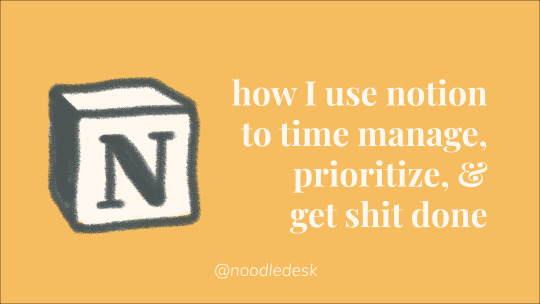

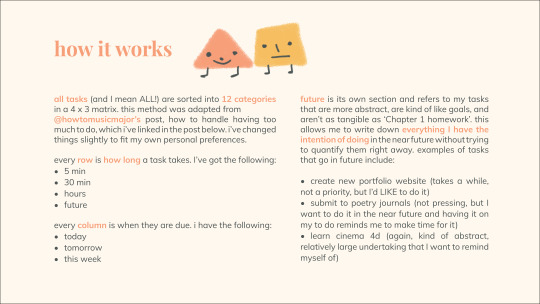
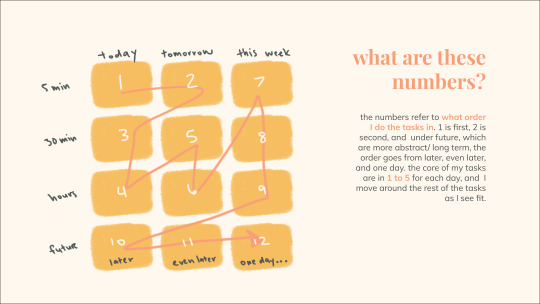
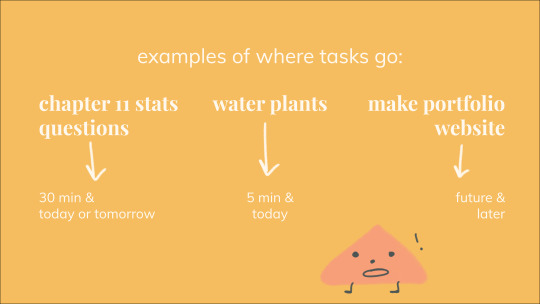
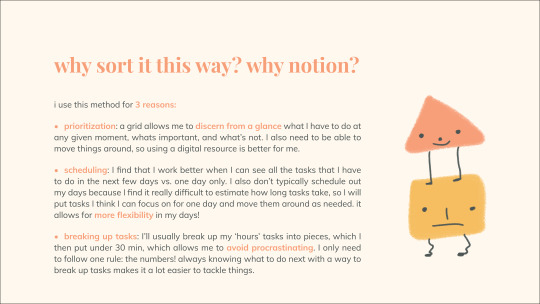



a lot of you have asked how I actually use notion in my day to day life, so I’ve broken down my task manager for all of you! hope this helps :) happy notion-ing! 💖
my other posts on notion: goal setting 📚
edit: i’ve made my template available for everyone to duplicate here! happy notion-ing!
entire post below!
how I use notion to time manage, prioritize, & get shit done
how it works
all tasks (and I mean ALL!) are sorted into 12 categories in a 4 x 3 matrix. this method was adapted from @howtomusicmajor’s post, how to handle having too much to do, which i’ve linked in the post below. i’ve changed things slightly to fit my own personal preferences.
every row is how long a task takes. I’ve got the following: 5 min 30 min hours future
every column is when they are due. i have the following: today tomorrow later
future refers to my tasks that are more abstract, fit are kind of like goals, and aren’t as tangible as ‘Chapter 1 homework’. this allows me to write down everything I have the intention of doing in the near future without trying to quantify them right away. examples of tasks that go in future include:
create new portfolio website (takes a while, not a priority, but I’d LIKE to do it) submit to poetry journals (not pressing, but I want to do it in the near future and having it on my to do reminds me to make time for it) learn cinema 4d (again, kind of abstract, relatively large undertaking that I want to remind myself of)
what are these numbers?
the numbers refer to what order I do the tasks in. 1 is first, 2 is second, and under future, which are more abstract/ long term, the order goes from later, even later, and one day. the core of my tasks are in 1 to 5 for each day, and I move around the rest of the tasks as I see fit.
example of where these tasks go:
chapter 11 stats questions → 30 min & today or tomorrow
water plants → 5 min & today
make portfolio website → future & later
why sort it this way? why notion?
i use this method for 3 reasons:
prioritization: a grid allows me to discern from a glance what I have to do at any given moment, whats important, and what’s not. I also need to be able to move things around, so using a digital resource is better for me.
scheduling: I find that I work better when I can see all the tasks that I have to do in the next few days vs. one day only. I also don’t typically schedule out my days because I find it really difficult to estimate how long tasks take, so I will put tasks I think I can focus on for one day and move them around as needed. it allows for more flexibility in my days!
breaking up tasks: I’ll usually break up my ‘hours’ tasks into pieces, which I then put under 30 min, which allows me to avoid procrastinating. I only need to follow one rule: the numbers! always knowing what to do next with a way to break up tasks makes it a lot easier to tackle things.
how to actually build yourself a grid in notion
sometimes it’s a little hard to build your own customized page in notion, so I started off with a template that would let me speed up my process. I used the weekly agenda template under the Personal category, but any page similar will be fine for you. from there, I just moved around each block until I got a 3 X 4 rectangle.
make it something you WANT to use
some ways that I make my task manager cute and enjoyable to use (you have to like your system or you won’t use it!)
cute cover photos every few days (change things up to keep your tracker fresh!)
recent excerpts from poems I read (inspiration!)
emojis that follow a theme & fit my current mood (tip: you can also use any image or transparent art that you want, so it’s super customizeable!)
and that's it!
finally, what’s most important is that you customize the manager so that it works well for you. if you notice that a process works better a different way, definitely change it! this works remarkably well for me because I alter it as I encounter better solutions. that being said, I hope this post was helpful! changing to this tracker has helped me much better manage school, being vice president of two clubs, my hobbies (like this blog!), sleeping enough, and making time for what’s important to me :)
references:
adapted from: https://howtomusicmajor.tumblr.com/post/130098710517/how-to-handle-having-too-much-to-do
art: https://hugolemonnier.tumblr.com/post/189172150081
poem by yang chia-hsien: https://aaww.org/summer-of-many-smokes/
#studying#tips#Time Management#advice#inspo#notion#mine#architstudy#gloomstudy#stillstudies#heymeraki#rivkahstudies#ohlookabii#studylustre#studyquill#rhubarbstudies#studyplants#theteadesk#heypat#moonshinestudies#heysareena
6K notes
·
View notes
Note
What’s the difference between someone with a badger primary model and somebody with badger values?
Great question, though I'm not sure you'll like my murky answer. At the end of the day, it's up to the person being sorted. If they feel that their Badger Primary values are strong enough to be a model, then it's a model. Remember that a model is who you've learned to be, down to your bones, through either positive or negative experiences. I think some people have mistaken the word "model" as meaning it's somehow less real or significant than an innate sorting, but it isn't. It's a part of who you are, and not something easily cast aside. If that's how a person feels about those Badger values, then I'd suggest they call it a model. But again, it's up to them. Of course, that begs the question: what about fictional characters who can't tell us how they feel about it? In general, you should use Occam's Razor whenever sorting characters. Don't over-complicate things. The simplest sorting that makes sense is the sorting you should stick to (until you get more character development that informs you otherwise). That said, I recommend considering where the character is getting these values from. All of the primaries can look like each other under the right circumstances. We talk the most about Birds building systems that look like the other primaries, but Snakes are considered Constructed too. They can build systems in the same way, although there's a strong pattern of them building systems based on the people in their circle. So, a Snake could adopt the same beliefs as their Lion best friend because what is important to their friend is important to them. In the similar way, a Badger is influenced by the people around them. If a Badger grows up in a community that values the pursuit of the truth, they can develop Bird values. And finally, we have Lions who can look like other houses because their feelings can lead them to all sorts of conclusions. Confusing enough for you? That's actually one of the things I love about this system though: with the right people you could have a scenario in which every single sorting comes to the same conclusion. It's all about how they get to that conclusion that we're examining. But I digress. My point, is that when sorting characters, I would first consider where they're getting their different primary values. If it's not linked to their innate primary, then I'd call it a model. If it can be linked, then I would consider if those values show any sign of changing when put under stress or into a different situation. If a Bird Primary is taught a system that contradicts their Badger values, how easily do they let go of those values? If they struggle to put aside their Badger values or if they somehow find a way to adopt their new system to still include Badger values, I would consider this a sign that those values go deep enough to be considered a model. It's a similar thing with the Loyalists. If they cut ties with people, do they also cut ties with the values they inherited from them? Does the Loyalist still refer to doing something because that's what their people would've done? Or did the Loyalist make those values their own? Lions are perhaps the most difficult to tell in this respect since feelings naturally change as people grow, sometimes regardless of external pressures. But if it's clear that they were taught a system from an outside source, that it didn't originate from or resonate with their feelings from the start, it's very likely a model.
At the end of the day though, there is no clear criteria for all of this. If we never get to see the characters' values tested in specific ways, I'm afraid it has to be left to the sorter's discretion. SHC is an art, not a science. It's up to the person being sorted or the person sorting the characters to interpret things.
#personally if I can link something back to a character's innate primary I'll need convincing evidence to call it a model#btw I consider myself a Badger with Bird values#sortinghatchats#the primaries#general sorting advice#ask response
30 notes
·
View notes
Note
Hi Chekhov! Really enjoying your white diamond au! I had a quick art question: How do you start comissions? I've been improving my drawing skills and thinking about drawing for others after having fun in artfight, but I don't know where to start? How much to charge, how to get paid, etc. Do you have any tips? Hope you're doing well! :)
Alright, since a few people have asked, I’ve decided to put together a few things about how to get started on commissions - what you need, what you should make, and how to keep things organized.
This will get a little long, so I’ll divide it into 4 main sections:
1) Draw Art - Getting started
2) Get Commissioned - Making a commission sheet, Advertising
3) ??? - Communicating, Setting Limits, Running the Business
4) Profit - Pricing Yourself and Getting Paid
* Disclaimer: I’m an artist, so this How-To will be illustration-focused. I’m sure many of these tips can apply to ANY types of commissions, but I will be focusing on the type I know best. If you are proficient in other types of commissions for other types of art - music commissions, photography, etc - feel free to chime in and leave a comment or make your own tutorial!

1) Draw Art
I think this is probably the most obvious part, but it needs to be said:
Before you start making art for other people, you must first be comfortable making art in general.
I’m not saying your art has to be Disney-quality, or industry-level! Not at all.
BUT! You must be comfortable creating what you sell. If you try to sell something you have little confidence in, you will stress yourself out and possibly end up losing time AND money.
Don’t shoot for the moon if you haven’t landed on it even once. Sell what you know you’re good at. Your commissions don’t HAVE to include full-body illustrations if you don’t know how to draw feet/solid stances. Limit yourself to what you can do.
Things you need to should probably have before starting commissions:
1. Access to art materials or a fully downloaded art program
DO NOT - Use a free tutorial version that will expire in a month and leave you without a way to draw! If you are having trouble finding a program, try free ones like MediBang Paint Pro.
2. Free time to complete the amount of commissions you want to take.
DO NOT - Take on or offer commissions if you KNOW you’re going to be overwhelmed with school or personal life for the next 2+ months. Pace yourself, otherwise you’ll burn out, get stressed, and get discouraged.
3. A reliable way to communicate with your customers like a commissions-only email
DO NOT - Use your friend/family/college email. It’s hard to keep track of things as it is, and creating new emails is easy and free. And keep it professional if you can! Not many people will reach out to dong-wiggles20434 to ask for a design. Ideally, your email should be close to your brand - however you want to brand yourself. Usernames are fine!)
DO NOT - Use Instagram/Twitter/Tumblr to collect commission info unless you are ready to do the organizing yourself. Some people make it work, but in my experience, if you use these SNS sites to communicate with friends and network... you’re going to be losing commission inquiries right and left and accidentally ignoring people. Email is much easier to organize and sort into folders.
4. A portfolio or at least 2-3 pieces of each type of art you’re planning to sell.
DO NOT - Advertise commissions without having any examples of the art you plan to sell. People will find it difficult to trust you if you can’t even give them a vague idea of what sort of drawing they’ll be getting.
Disclaimer: These are not hard ‘do not’s. If you have had a different experience, I respect that. I’m simplifying for the sake of streamlining this advice.
.
2) Get Commissioned
So - you have your art, you have your art program, and you’ve got all the time in the world. That means.... that’s right! It’s time to let the world know you’re taking commissions.
One of the most common ways artists signal to their audience that they can do commissions is by creating a commissions sheet. There are MANY ways to make this - and they range from simple and doodly ones to VERY complex designs. For example, here’s mine!
There are many ways to organize a commission sheet. At its core, a commission sheet should display the types of art you WANT to be commissioned to make. Let’s go over a few ways they can be done!
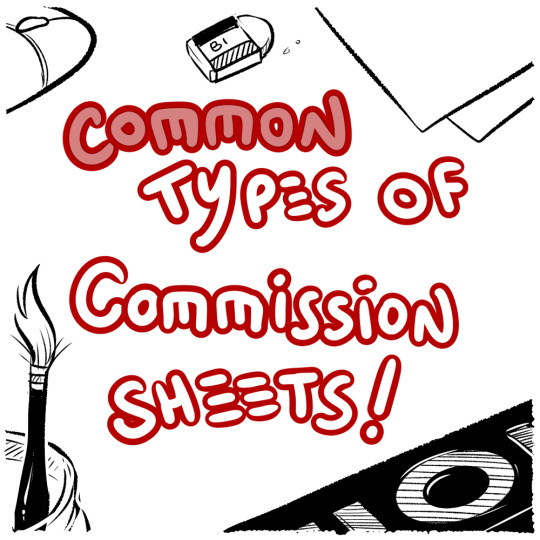
#1.... Body Portion Dividers!

This sheet is most common with those who want to capitalize on drawing people and characters. If you want to draw lots of characters, this is a great way to offer several tiers of pricing based on how much of their character your customers want to see.
#2... Complexity Scale

If you’re open to drawing many things but want to base your pricing off of how complex something is, you can split your tiers into done-ness. This type of commission is popular with those that draw characters AND animals, furries, etc.
#3.... Style and Type

If you’re more on the design side of things, or if you have various niche art styles that you can’t quite lump together, display a variety of your skills alongside each other! It helps if all the ones you have can be organized under a common customer - like those looking to advance their own business and get logos, websites, or mascots made for them!
.
3) ???
You got your first commission... what happens now???
Well, ideally you have the time, tools and motivation to make things happen! Now all you have to do is... sit down and... draw.......
I’m going to say something that may be a little controversial:
Commissions aren’t fun.
No, no, hear me out: I have fun doing commissions! I genuinely enjoy drawing characters and coming up with designs. But even with all that said, commissions are, first and foremost: WORK
I’m not saying this to discourage you, I’m saying this to keep things realistic. When I first began commissions, I thought it would be just like any other type of drawing. I would sit down, imagine a thing, draw it... it would be fun!
But then I realized that I couldn’t just draw what I wanted - another person had an idea in mind and had asked me to do it. I stressed over getting the design correct from descriptions. I stressed over not having the right reference for the pose the commissioner wanted. I stressed over not being able to draw the leg right in the way I had promised I would do. I stressed about billing. I stressed about digital money transfers. It was difficult, and time-consuming, and I did not enjoy it. At all.
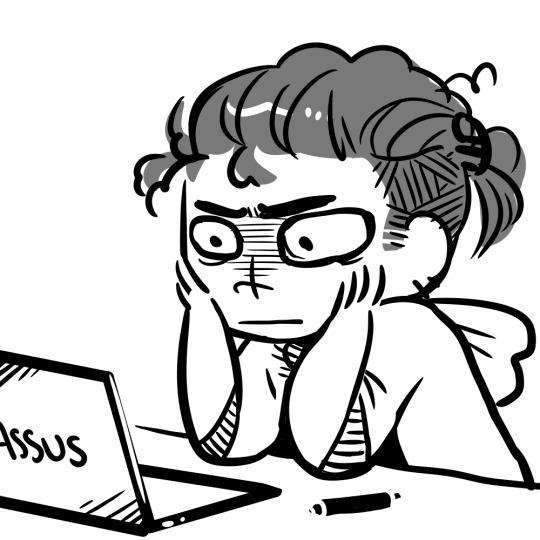
And a part of that is definitely on the commissioner - we, as artists, NEED to demand proper references or descriptions. We, as artists, NEED to limit the amount of changes we’re going to make at the flick of a finger. We NEED to demand clear instructions and set boundaries. That’s also super important.
But also - don’t be discouraged if you find yourself exhausted drawing your first commission. MANY artists go through this. Adjust your rules, fix up your limits, practice putting your foot down on finicky commissioners who expect you to read their mind! It does get easier, but you have to communicate and put in the effort and act as your own manager AND your own customer service AND your own accountant. That’s what you’re looking at.
Good limits and boundaries to set:
Limit the amount of changes a person can ask to make. “I want blue hair.” Next email: “No wait, yeah, make it red.” Next email: “Actually I changed my mind, can I get the blue but like, lighter?” Next email: “No, not that light.” ... At some point, we have to stop. I personally allow 2-3 changes on the final stages of a commission before I start refusing or start asking for extra money.
Demand clear instructions and/or references. If something isn’t described, you have to take artistic liberty and design it, but that’s difficult! And if the customer is not happy with it but can’t tell you more? That’s not your problem - the burden of reference is on THEM. You cannot read their mind, and that’s not your fault.
Get at least half the payment up front! This is a good balance between the ‘pay before art’ and the ‘pay after art’ conundrum that will limit the amount of woes between artist and customer. (I’ll touch upon this a little more in the Profit section.)
Organization:
Where possible, create good habits! Tag your emails and organize your folders. I have a tag on my emails for active and finished commissions. I also keep my emails on Unread until I have time to sit down and properly look at/reply to them.
My Commissions in the folder are also organized chronologically and I mark down which ones are paid and which ones are not.
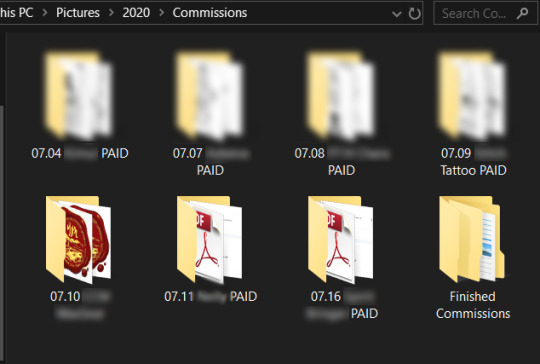
(I understand not everyone can do this, but if you want to give it a try, it does make things easier in the long run. Again, this advice is just what I have found personally helps.)
One last thing - I do not want to shame ANYONE for taking their time with commissions! Commissions are complex, and they take time and work. You can draw in 8 hours, but some things take research, materials, etc. Some illustrations realistically take up to half a year, or, depending on what’s involved, several years!!
THAT BEING SAID - it’s good manners to be upfront with your customers about how long you expect the commission to take. If you think you’re busy, just say that! Explain that you have a lot going on, and you will probably take (insert time period here).
And if your commissioners are worried, work out a system to keep them updated! I send my commissioners updates when I finish the lineart/flat colors/etc and I try to be clear about how long everything will take. I try to estimate with a +3-5 days buffer to give myself extra time... and recently I’ve been using it. Always say a bigger number than you think you’ll need.
If someone wants a rushed commission... make them pay more. If ANYONE wants a commission done ‘by the end of the week’ - that’s an automatic rush-job for me because I’m juggling an irl job and several commissions at once. I WILL charge a rush fee and I won’t feel bad about it.
If someone wants a commission within 24 hours...... Well, they better be paying you 3x your normal amount, or more. And remember - you CAN refuse! It’s perfectly reasonable to say ‘No, sorry, that sort of turnaround time is not realistic for me.’
Food For Thought - Invoicing
Many artists I’ve commissioned in the past have not used Invoicing, but I’ve recently begun to fill out invoices and file them in my Commissions folder just to keep track of things. It’s not necessary until you start getting into the Small Business side of Freelancing, but it’s not a bad idea to get into the habit early in case you might need to do it later for tax purposes.
Here’s what my Invoice looks like, for example.
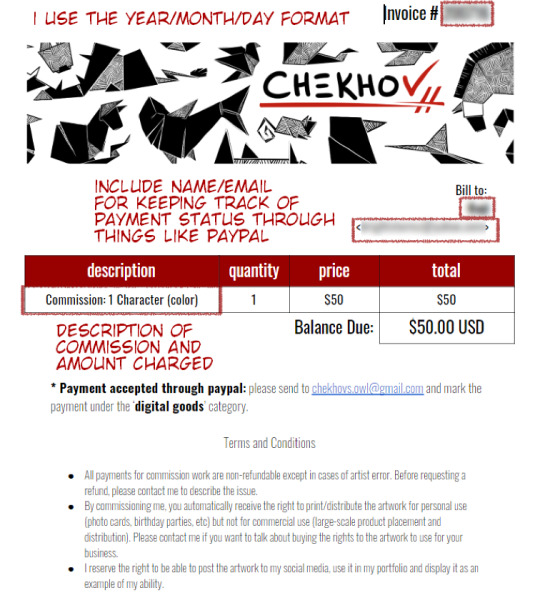
I’ve optimized it to help me remember who, what, and how much is involved! It also contains important info for my customers like where to send the money.
Which brings us to...
.
4) Profit
One of the hardest things for artists is pricing themselves. I’m not going to tell you which way is BEST - there is no BEST way, only the best way for YOU.
One of the options available to you is pricing by the hour. It includes averaging out how long it takes you to draw a specific type of art (whatever you’re offering as a commission) and multiplying that by an hourly wage you’ve decided on.

When you do this, I stress - do NOT price yourself below minimum wage if you can help it. When you first start out, aim for the $15/hour mark and adjust accordingly.
Other ways to price your art:
- Per complexity: Portraits vs full body should be scaled based on how difficult you find one vs. the other. You can also easily decide on a price for a sketch and double it for lineart, triple it for full color, etc.
- Per type: Look up for industry prices for website design and logo design. They may surprise you! You don’t have to charge that much, but it helps to keep things in perspective.
It’s okay to change your prices! Keep your commission sheet image handy so you can update the amounts as you grow. :)
Payment up front or after completion?
Some artist take full payment up front. Some only demand payment after they’ve finished and sent out the piece. I personally think these are both risky for everyone involved.
I recommend doing at least HALF of the payment BEFORE you start the commission. Calculate your full price and ask for half before you start working on it in earnest, to make sure the person can actually pay you. Then, when they receive the full piece and are satisfied, they can complete the payment.
I personally work in this structure:
> Someone emails me with their idea/reference
> I send back a rough draft sketch that shows the idea/pose (only takes me 10-20 minutes so not a huge loss if they ghost) and quote them a price
> They can pay the full thing upfront OR pay half
> I finish the commission and send updates when I do the lineart/colors to double check anything so they have multiple chances to spot any errors
> If the person paid only half on completion, I send them a low-res version of the finished thing, they finish up their payment and THEN I send them the full-res version plus any other filetypes/CYMK proofs, etc.
Many of the people who commission me pay me up front even though I offer they pay half - and I’m really flattered that they trust me that much! Because of that, I feel encouraged to update them frequently and ask for their input as I work, so they have the peace of mind knowing I’m actually doing their commission.
Great, but how do I get PAID????
There are NUMEROUS ways - these days money is relatively easy to transfer over digital means, and you have a few options.

Paypal is perhaps one of the oldest digital wallets and is geared towards businesses. By setting up a PayPal and connecting it to your debit card of bank account, you can tunnel a pathway from your online business directly into your hands in a matter of days.
Paypal also offers Invoicing - you make an invoice, price it and send it to the person’s email and they can pay whatever way they need! (It also allows partial payments.)
Pros: transfers from PayPal to bank account are free, and take a couple of business days. It also has no upper limit to the amount of money you can move in/out each month. It can force refunds due to the nature of its business-oriented payment system.
Cons: Because it’s used by businesses for larger transactions, PayPal may demand a more rigorous proof of your identity. It may also take longer to set up and be harder to get used to. I’ve also heard that they can be a hassle when it comes to closing your account.

Venmo is another type of digital wallet that acts much like paypal, except for a few key differences - it is NOT made for businesses (so depending on whether you’re officially registered as a freelancer, you may not be able to use it). I personally don’t use venmo, so I cannot speak to its usefulness, but I know a few people that use it for casual transactions. It’s easy and quick! :)
Keep in mind that you cannot force a refund over venmo! The transactions are final.
There’s also CashApp, GooglePay (which could load gift cards but also allows peer-to-peer transactions) and I’ve heard good things about Due, though I’ve never personally used it.
Other ways to pay: I’ve had people pay me over Patreon by upping their pledge, and I’ve had people pay me over Ko-Fi by donating a specific amount.
Many people even use Etsy - the website specialized for independent small businesses selling art - by listing their commission sheet and offering up several ‘slots’ of commissions, which allows you to track taxes AND allows your clients to pay using whatever they feel comfortable with.
If you’re in Canada, you can even pay by emailing money directly from bank account to bank account - check whether your country offers this type of service! There’s no shortage of ways to move money in the digital world.
Just like everything else, there’s no singular ‘Best’ way. It just depends on what works for you.
I think that just about wraps it up! I can’t quite think of what else to put here - but I’m sure other artists will chime in with their own advice. :) I’m very sorry this became so long but I hope it was helpful!
Obligatory Disclaimer: I’m not qualified to give legal or accounting counsel. Please double-check the laws in your own country/state in regards to taxation of freelancing work and do your own research. If you are underage, DEFINITELY get an adult’s permission before you start doing commissions, and have the adult help you through the process.
. . . . . . . . . . . .
OTHER POSTS YOU MAY FIND USEFUL:
An Extended Post on Pricing Yourself for Commissions
Dealing with Imposter Syndrome/Feeling ‘Not Good Enough’
Growing Your Audience
Advice for Starting Digital Art
2K notes
·
View notes
Text
Mass Effect development insights and highlights from Bioware: Stories and Secrets from 25 Years of Game Development
This is the Mass Effect version of this post.
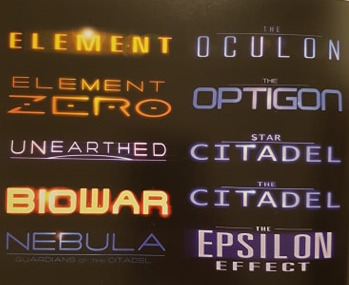
[In case you can’t read it the subtitle in the bottom left logo above is “Guardians of the Citadel”]
Note: Drug use is mentioned.
Cut for length.
Mass Effect 1
ME began its life in a vision document in fall 2003
Codenamed “SFX”
Conceived of by Casey Hudson and a core team from KotOR. Its genesis was the intention to create an epic sci-fi RPG in an original setting that BioWare owned (so they could have full creative control), and in a setting that was conceived of first and foremost as a video game
Initially players could control any squadmate, but they wanted it to be about Shep and for players to be focused on Shep being a battlefield commander, rather than on switching bodies
By the start of 2004 its story was shaping up. Initially humans landed on Mars in 2250 and discovered evidence of an ancient alien race and a powerful substance, Black Sand, which rapidly advanced tech to the point that FTL travel was possible. (My note: obviously now the Prothean artifacts on Mars & associated mass effect force tech enabled this in the final canon, but I wonder if aspects of the ‘Black Sand’ naming-type & powerful substance stuff was rolled into red sand from final canon) Humans were suddenly capable of travel to multiple star systems and made contact with a multitude of other species. At the start of the first game, these species together with humans had a fragile peace, with focus placed on the political center of the galaxy, a hub known as Star City, later renamed the Citadel
Multiplayer was a vision for the series as far back as 2003. The plan was for ME1, an Xbox exclusive at launch, to take advantage of the platform’s online components. Early designs saw players meeting in one of the central hubs to interact and trade items in their otherwise SP adventures
By 2006 it had the name ME and the story was more specific, with the theme of conflict between organic and synthetic lifeforms. The story’s scope now stretched across 3 games and included scope for full co-op MP
They tried to do MP in every game, discussing it from the get-go, but it always just fell by the wayside. “When you’re trying to build something that is a new IP, on a new platform, with a new engine, you’ve got to really focus on the core elements of the game.”
The conversation system prototype was made in Jade Empire, and some of ME’s earliest writing was done in an old JE build. At first there was no conversation wheel. Paragon was “Friendly” and Renegade “Hostile”. In the prototype Shep was a silent unnamed Spectre. Many conversations in the prototype about the player’s choice in smuggling a weapon through Noveria made it into the game
In said prototype a merchant referred to themselves as “this one”, though the word hanar never appeared. The PC in it also had the option to end a conversation with “I should go”. In the prototype also, Harkin was voiced by Mark Meer
An early version of the Mako got used as the krogan truck in ME2
Early concepts of the Citadel were drawn in pencil by CH. A piece of concept art of its final design was painted based on a photo of a sculpture near Aswan, Egypt
As with any new IP naming it was a struggle. They put out a call to all staff for ideas, did polls, made a name generator that combined words that they liked in random ways and made pretend logos of ones they liked in Photoshop to see if they could make themselves love the name or find visual potential in it. (Some of these names are in the pic at the top of this post.) CH liked “Unearthed” as it was a reference to Prothean ruins dug up on Mars and humanity’s ascendance going away from Earth. They knew the game would have a central space station featuring prominently so some of the ideas were based on that - “The Citadel”, “The Optigon”, “The Oculon”. “Element” was another one they had in mind due to the rare substance in the game
CH: “I was a big fan of John Harris’ book Mass, which had epic-scaled sci-fi ideas, so that was a word that came up often. Many of the names came from the idea that the IP featured a fifth fundamental physical force (in addition to the known four of gravitational, electromagnetic, strong nuclear and weak nuclear) so the word ‘effect’ came up pretty often.” Ultimately none of the ideas really felt right. One Monday morning they were going over the names and Greg Zeschuk said he had an idea on the weekend: “Mass Effect!” CH: “I said, ‘I don’t hate it’, which in the naming process is a high compliment. And it stuck!”
CH on Shep’s Prothean vision from the beacon: “It was hard to imagine how we would do this. CG was - and is - really expensive. Instead I wanted to try doing it through photography and video editing. So I went to a local grocery store and bought a few packages of the weirdest looking meat that I could find. Then I set up a little photoshoot in my basement, complete with some electronics parts and some red wine for juicyness.” He used these props to create a video sequence where the photos were rapidly cycled and blurred, along with production paintings, to create the scary vision an organic/machine experiment on the Protheans. These mashups were also used as inspiration for concept artists and level designers who were working on these themes
Tali used to be called Talsi
On the licensing side they often joke that they’re licensing N7 not “Mass Effect” due to N7′s popularity
There was a confidential internal guide to the IP in 2007 to help devs along and summarize/synthesize the vision etc. Some excerpts from it are shown in the book and this is the first time the public have ever seen them
Early versions of Asari had hair
Asari were designed as a nod to classic TV sci-fi (with human actors wearing obvious makeup and prosthetics to play aliens)
The turian design guideline was “we want them to be birds of prey”. They also wanted a range of alien types, some close to human like Asari, while others were to be a lot further away, like turians
BioWare patented the conversation wheel, which was a first for them. CH had been frustrated with reviews of Jade Empire that said that the actioncentric game was too wordy [with its list dialogue]. “I’m like, story is words. [...] What is it about our games that is making people feel like they’re wordy?” Then he thought “In a game you kind of need to feel like you’re continuing to play it. Maybe you should continue feeling like you’re playing it actively into the dialogue.” “[The wheel] kind of gave a new experience with dialogue when you did start to react based on emotion, and that’s ultimately what we’re trying to bring out in our games”
The original krogan concept was based on a bat “with a really wide squidgy face. We just used its face on top of this weird body and it kinda worked”
Geth musculature was based on fiber-optic cables, with flexible plates of armor attached
The vision for the IP was 80s sci-fi inspired space opera
The concept art of Saren lifting Shep by the throat inspired a similar scene in-game. The staging wasn’t planned til designers saw that art
A squadmate with Shepard on the way to meet Ash in an old storyboard was called Carter. Early name of Kaidan or Jenkins?
Bono from U2 was kinda instrumental in bringing us ME lol
Finding the right cover art for ME1 was notably tricky
Matt Rhodes got his start drawing helmets for ME1, including one which would become Shep’s “second face”. He estimates he drew between 250-270 different ones
Some of the sounds in-game were people smashing watermelons with sledgehammers and sticking fists into various goos
The audio team had fun trying to slip the iconic main theme into unexpected places throughout the MET. “We were very aware of how powerful that track was for the fans and it was tempting to overuse it for any moment we wanted to make really emotional”.
The theme was creatively repurposed in ME3: slowed down and reworked as the ambient sound for the SR-2. “If you listen to it for a really long time, just stand in the Normandy and listen, you’ll actually hear the notes change slowly. It doesn’t sound like music, it sounds like a background ambiance, but it’s there.” (My note: Well no wonder the Normandy feels so much like home?? 😭 sneaky..)
Bug report: “Mako Tornado”. There wasn’t enough friction between the tires and the ground, causing testers to lose control of the vehicle and send it spinning into the air like a tornado. “As it turns, the front end comes up, and then it starts spinning and spinning and spinning and spinning faster and faster and faster until it just flies up in the sky” (My note: Sounds like a regular day in the Mako to me)
Cerberus originally had a bigger role in this game. It was cut but they had a whole explorable outpost. “I called it Misery,” says Mac Walters, “It was this planet with a little outpost that said ‘Welcome to Misery’”. Everything on the outpost was shit - dirty worn stuff, no windows, no kitchen, the vehicle bay was open to the elements etc
The Reaper sound is literal garbage. Some audio designers went on a recording trip to a national park. One of them got fixated on a garbage can, “a metal bear-proof receptacle with a heavy lid that creaked horribly when opened”. “It was like, ominous, spooky, tonal and almost musical. I decided to throw a mic into the garbage and record it moving. I didn’t know what it was going to be until later”
They were making lots of noises to record like throwing logs and rocks around. An old couple peered at them through the window of their camper van in the woods and must have called the cops because then the cops showed up, pulled them over and told them to stop. The cops towed their car (the driver’s plates were Cali plates and expired), drove them to Edmonton outskirts and then the audio producer Shauna got a call and had to go pick them up “like three little boys”. “We got a stern talking to”. Once back they were playing around with the garbage sound, editing it etc. Casey heard it and proclaimed “That’s the sound of the Reapers”
Preston Watamaniuk: “There are things I could have done to Mass 1 to make it an infinitely better game with better UIs” and some simple cuts and changes. “But when you’re living with it, it’s very hard to see those things”
BioWare Labs
As social media and smartphone games exploded, BioWare dedicated a small team dedicated to exploring opportunities here - BioWare Labs
Mass Effect: Galaxy used a unique graphic art style and static visual presentation common in visual novels. It has the distinction of being the only iOS game BW have made during their first 25 years
Scrapped ideas were a 3rd person space shooter called Mass Effect: Corsair and 2 DA titles - a strategy game and a top-down dungeon crawler starring young Wynne. (My note: Maybe the corsairs stuff was rolled into Jacob’s backstory in 2, the Alliance Corsairs)
Corsair was a very short-lived project that never got its feet under it. It was a spin-off on Nintendo DS featuring a behind-the-ship perspective and branching dialogue. At one point it had MP. The idea behind it was basically “ME: Freelancer” - fly your ship around, do missions, get credits. It had a limited branching story but was a gameplay-centered experience intended to fill the gap between ME1 and 2. That gap ended up being filled by Galaxy
Galaxy and Corsair’s smaller screen allowed concept artists to use bold colors and a simplistic character design style to help those games stand out from Shep’s story
Nick Thornborrow did some art for Corsair but was worried his art style didn’t fit ME. He moved to DA where he feels his art style fits better
Lots of BioWare VAs and even a lead writer and the VO director are drawn from Edmonton’s local community theater scene, which is vibrant. Think this is how Mark Meer got involved
Mass Effect 2
Player choices carrying over was a first for BW
Dirty Dozen-inspired plot
Its plot is a web of conditionals (see Suicide Mission)
Was more of a shooter than anything BW had made since Shattered Steel
There was 2 camps on the team, those who wanted to push combat and systems forward and redefine the ME experience and those who wanted to make a true sequel, with the same gameplay and systems but a new story. Karin Weekes: “I think it ended up being a good push-pull. It felt like a pretty healthy creative conflict”
“ME2 was a game you could hold up to someone who argues that games aren’t a serious medium and go ‘Oh yeah, then why is Martin Sheen in this?’” Sheen was their first pick for TIM
The idea for TIM came from a mash-up of concepts CH had collected over the years. The name “Illusive” originally came from his pitch for naming DAO’s Eclipse engine, a word inspired by Obi-Wan’s line “It’s not about the mission, Master. It’s something... elsewhere. Elusive”. “I thought, what if we called our next engine 'Elusive', but used an ‘I’, and then it’s like ‘Illusion’. [...] I still really like the word with an ‘I’ and what it conjures”
When ME1 DLC was in production, CH had been watching a lot of CNN, specifically Anderson Cooper. “How is one guy travelling to all these places and never looking tired and always being able to speak with clarity?” CH says it seemed almost superhuman. “What if there was someone who is the absolute maximum of the things you would aspire to be, but also the worst of humanity?” Cooper, though not evil, became an inspiration for TIM down to the gray hair and piercing blue eyes
Inspiration for TIM’s behind-the-scenes role pulling political strings came from Jack Bauer’s brother Graem in 24. Graem “can call up the president and tell him what to do and hang up, because he’s so connected and so influential”. Sheen had played a president and his performance brought gravitas and wisdom to the role. He had quit smoking, but the character smokes. He didn’t want to fake it, but he also didn’t want to smoke, “so he actually asked for a cigarette” to hold so he could stop his words to take drags with natural cadence
Writing was still pushing to write and revise lines hours before VO started. A series of problems like injury and some writers leaving for other opportunities left it so that Karin, Lukas Kristjanson and editor Cookie Everman hand to land the story safely, with PW helping where they could. Lukas: “We took over the writing bug and task list, and I can’t stress enough how much [Karin and Cookie] did to get ME2 out the door. There’s no part of that thing we didn’t touch”. Karin: “That was the most dramatic 2 weeks of my life”
Initial fan reaction when they started promo-ing ME2 was very negative because people didn’t want to know about new chars like Jack and Mordin. “[fans were like] ‘Get them out of here. We want our characters from the first game’. But then when they played them, those became some of the most popular chars [of the series]”
Concept art of Thane has an idea annotation saying “Face can shapeshift?”
At one point when designing Thane concept artists sent multiple variations of him to the team asking them to vote on which was the most attractive
Most of the Normandy crew was written by lead level designer Dusty Everman. Lukas gave him advice in the evenings between bugs
BioWare Montreal made ME2 and 3 cinematics
CC for Shep was based on tools used by char designers to create in-game chars. Under the hood similar tools existed to create aliens
Aliens were much easier to animate than humans. When something is human it’s very difficult to make it look realistic and you can see all the mistakes and everything
Over the holiday period in 2007 CH worked out a diagram on a single piece of paper that would define the entire scope and structure of the game. The diagram is included in the book
Bug report: “I shot a krogan so hard that his textures fell off”. At one point shotgun blast damage was applied to each of the pellets fired, and shot enemies ended up with just the default checkerboard Unreal texture on them after their textures got blown off
Blasto was meant to be 1 step above an Easter egg but his fan popularity prompted them to bring him back in ME3
They rewrote chunks of Jack 2 days before she went to VO. She was the only one they could change because all the other NPCs were recorded. They redesigned her mission by juggling locked NPC lines and changing Shep’s reactions by rewriting text paraphrases to change the context of the already-recorded VO
Lukas snuck obscure nods ito ME2′s distress calls. In the general distress call for the Hugo Gernsback, there’s BW’s initial’s and Edmonton’s phone number backwards. In a fault in a beacon protocol there’s the initials and backward phone number from Tommy Tutone’s “Jenny”. In 2 other general distress calls there’s initials and numbers from Glenn Miller Orchestra’s “Pennsylvania 6-5000″ and initials and numbers from Geddy Lee and Rush’s “2112″ respectively
Mass Effect 3
“The end of an era marks the beginning of another”
ME3 “marked the end of Shep’s story”
Saying bye to Shep was as difficult for devs as it was for players
JHale’s final VO session included Anderson’s death and romanced Garrus’ goodbye. “We were in the session and we both just started crying”, Caroline says. “I couldn’t come on the line to give her notes because I was crying, and she was crying. And so there was just this minute-long pause of like, nothing, nothing, nothing - just silence through the airwaves. And then I came on and just told her that I was crying and she said ‘I’m crying!’” They talked about these anecdotes also here on the N7 Day reunion panel
The Microsoft Kinect voice support required devs to teach Kinect hundreds of commands in a variety of accents across multiple languages. The result was useful but made for some awkward moments. Numerous players accidentally said “geth” or “quarian” while making a particular decision and accidentally killed Tali
MP chars were voiced by cops and military people
The helmet on one of the MP chars was originally designed for cancelled project Revolver
The payload device at the end needed to attach to the Citadel while essentially serving as a giant trigger. “It ended up becoming quite the engineering feet just to visualize how this thing would move and connect to the Citadel”
Concept artists explored creating an anti-team, where Kai Leng was almost an anti-Shepard essentially, with an elite squad to counteract your team. This idea never went beyond concept phase
ME3 Special Edition was released on Nintendo Wii U exclusively. This exclusive version of the game includes Genesis 2 (a sequel to the original Genesis comic) and unique gameplay features that took advantage of the touchscreen GamePad. For years Sonic Chronicles: Dark Brotherhood had had the honor of being BW’s only game made for a Nintendo console
FemShep regrettably didn’t feature in major ME marketing til ME3. Later releases like DAI, MEA and Anthem have taken increasing care not to gender their protagonists in cover art
To capture combat sounds they took a trip to CFB Wainwright, a military base southeast of Edmonton. They got a big tour of it and were allowed to record anything they could find. The tour ended with them getting to drive and shoot tanks (real shells). The force of doing that sent waves through Joel Green, he felt his whole chest compress when it went off; the perfect sound for the Black Widow! After the trip the soldiers let him keep the shell he fired and it’s been passed on like a torch to various devs since
Kakliosaurs began life as a joke in the writers’ room after John Dombrow placed a Grunt figure on a t-rex toy he had on his desk. Lore was brainstormed to justify the mash-up before someone asked, “Why don’t we put this in the game?” They loved it so much Karin had custom coffee mugs made
Bug report: For a while Tali’s final romance scene would fire when she was supposed to be dead
“Balancing combat: how designers in ME3 entered an ‘arms race’” - the solution to players feeling OP vs players feeling frustrated by really strong enemies is to find a good middle ground, but for designers Corey Gaspur and Brenon Holmes, it was war. Brenon designed enemies, Corey designed guns. Corey “was obsessed with bigger, heavier guns. We had this sort of informal competition where he’d make this crazy overturned gun that would just murder all the enemies, and then I tuned some stuff up to compensate”
Brenon had to invent new ways to “stop Corey” and this led to the Phantoms. Corey had in turn designed consumable rockets that could wipe out entire waves of enemies. He must’ve figured this would make short work of Brenon’s space ninjas, but Brenon had other plans: “I had just added the ability for her to cut rockets [when Corey was playing MP and he was watching]. She cut the rocket in half... Corey just turns and looks at me and is like: ‘Really dude? I just shot a rocket at this Phantom and she’s fine? Not even damaged? Zero damage?’”
This friendly rivalry helped elevate ME3′s gameplay. Corey had a knack for making a gun feel so good to fire it had his fellow designers scrambling to keep up. It was his version of balancing. Before Corey sadly passed away he mentored Boldwin Li in all things weapon design and the arms race continued
Corey designed the Arc Pistol. It was causing problems for enemies because it was too powerful. It seemed hell bent on staying that way, Boldwin would tune down all its stats and it was still doing 3x the damage it should have been doing. “I was like ‘What the hell?’, and then I looked closer. It secretly fired 3 bullets for every pull of the trigger! Corey, you sneaky jerk”
The day it launched there were midnight launch parties across North America including one near the BW building. Numerous devs sat at long tables greeting fans and signing autographs as the fans picked up preorders. When midnight struck the line was long enough that it took several hours for some fans to get their game. One particular fan is remembered: “It was 3am. Some guy drove up from Calgary with his friends. He was like one of the last people in line. I think he was sort of tired-drunk. He threw himself across the tables, pulled up his shirt and shouted ‘Guys, sign my abs!’ And like I did, because he waited so long. It felt impolite not to. So I hope he enjoyed his copy of ME3″
For designing Protheans concept artists had free reign to design something that read as ancient
Before the concept art team had the story of the game to work toward, they explored wild ideas of their own including an image of the crew stealing back the Normandy to go after the Reapers
Jen Cheverie was testing scenes and was initially excited to be testing Mordin scenes, til she saw she was testing the Renegade version of his death. “This is even before like all of the audio and everything was in, so you didn’t even have the sad music. I remember sitting at my desk and my hands just went to my face when I saw that the gun Shep pulls on Mordin is the gun he gives Shep in ME2. I burst into tears and was crying for the rest of the day. People are waving to me as they walk by and I’m like, ‘It’s ok, I’m just killing my best friend’”
There’s a segment called “Shepard’s story ends”. Casey on the ending: “There’s a whole bunch of things that come together to make it incredibly tense and emotional for players. I think the biggest one was the sense of finality, that whatever it was that happened in that very last moment... was it.”
Wrapping up the story was a massive feat. In a way all of ME3 is an ending. Its final moments were the players’ last with a char they’d been with all the way from Eden Prime
“And while the critical reception of the game was extremely positive, many fans were unsatisfied with the ending, which became one of the most controversial in the history of games.” CH: “We were, on one hand, at the end of a marathon trying to finish the game and the series. But as devs we also knew that there would be more. We knew that we would continue to tell the story. In retrospect, we didn’t fully appreciate the tremendous sense of finality that it would have for people”. He envisioned an ending that posed new questions, something in the tradition of high sci-fi that left players dreaming about what that particular galaxy’s future could hold. “Frankly, there’s a lot more that we could have and should have done to honor the work players put in, to give them a stronger sense of reward and closure”
AAA games are massive undertakings with a million moving parts. Somehow they come together but even the best-planned projects don’t turn out quite like devs hope. From start to end video game production is a series of compromises. It’s rare if not impossible for devs to ship a game they’re entirely happy with. “I think that people imagine that when you finish a game, it’s exactly the way you wanted it to be. But whether people end up loving or hating the final result, we work hard to finish it the best we can, knowing that there’s a lot we would have wanted to do better. I think that’s true of any creative work”
As the dust settled after the initial reaction to the ending and later its epilogue, meant to show the wide-reaching ripple effects of Shep’s final choice, “players emerged mostly asking for one thing”. CH: “Now, most of what we hear, after both ME3 and MEA, is ‘Hey, just go make more Mass Effect’. And that to me is the most important thing. Knowing that players want to return to the ME universe is what inspires us to press on and imagine what comes next”
Mass Effect: Andromeda
By creating a new ME in a new galaxy the team was challenged to put their own visual stamp on the game while keeping it true to the franchise
Being the first ME game on a new gen of consoles meant for more detail
“Massive transport ships called arks populated with salarians, turians, humans, asari and quarians” made the risky jump to the Cluster
MEA was the first time BW had truly codeveloped across 3 studios: Edmonton, Montreal and Austin. The bulk of the work especially early on was done in Montreal, which was composed of a handful of Edmonton expats and heaps of experienced devs who joined from elsewhere specifically to bring a new ME experience to life. Series vets in Edmonton then came on to contribute writing, cinematics, design and QA, along with leadership from creative director Mac Walters and the core Production team. Austin writers and level designers also joined the fray
“It took a new team to take ME beyond the Milky Way”
Mac: “A lot of people in Montreal joined BW as fans of the franchise, so they just had this passion, and it felt like it was more like the days of Jade Empire, where a smaller younger team gets to do something for the first time. Even though it wasn’t necessarily a new IP for me, it felt fresh and new because of that. The team was just super excited to be working on it”
Early plans had the player exploring hundreds of worlds, procedurally generated, allowing for a nearly infinite variety of experiences. But as development wore on, it became clear that the game narrative required more specific, hand-touched level design on each world to keep the story focused and the experience engaging. “The plan was to give players numerous uncharted worlds to explore. Designers worked hard to come up with procedural elements that would make such planets special. Eventually the team made the difficult decision to abandon procedural planets in favor of more memorable hand-touched alien worlds, each with a specific story to tell”
One challenge was defining what ME meant without Shep. Care was given to include many of the MET’s key species. “Ryder recruited turian, asari, krogan and salarian followers”. Like Shep Ryder represents humanity’s hope for a peaceful coexistence among aliens who had long operated without human contact
Beginning with MEA the team decided that with few exceptions vehicles in ME have 6 wheels. Early Nomad concepts were bulkier. Later ones focused on its ability to move over its ability to protect itself from hostile fire, underlining the themes of exploration
German concept designer and auto-motive futurist Daniel Simon was contracted to create the Nomad and Tempest. The Tempest’s final design took inspo from the Concorde
Concepts for angaran fighter ships have the following notes: “Two doors swing open, wings rotate down to function as landing struts, the landing struts split open. It has a spinning turbine engine
Despite being set a galaxy away and some 600 years after Mordin’s death, there was a time when he had a cameo. It wasn’t cut due to running out of time however, it was cut due to drug references. John Dombrow explains: “One day I had to write a small quest for Kadara. I thought it’d be amusing if these 2 guys living way out on the fringes in a shack were growing plants for uh, medicinal purposes, and needed Ryder’s help with it. It occurred to me, wouldn’t it be amusing if Ryder had the option of actually trying ‘the medicine’ to see what would happen? And I thought, what if it turned into some hallucination that somehow involved SAM - like maybe SAM would sing? But why? How could I motivate that? Then it hit me. Who else in the ME game sings unexpectedly? MORDIN. As a nod to him I wrote SAM singing Modern Major-General. It got even better when our cine designer John Ebenger wanted to take it even further. Bless him, he came in on a Saturday to do a special hallucination showing Mordin himself. It was great. Til the fateful day we were told MEA had already been submitted to the ratings board. That’s when you declare things like drug references in your game. Mordin fell under that category which meant it was a no-go. We were too late”
Ryder’s white AI armor contrasts Shep’s iconic dark armor (intentional design)
Concept art for Ryder involved experiments with cloth (cloaks, ponchos, capes - “Pull here to release cloak”) and asymmetrical design elements
For alien design, there’s a few exceptions but humanoid figures are the ME standard and this persisted into MEA
Kett and angara concepts explored striking lines and textures
– From Bioware: Stories and Secrets from 25 Years of Game Development
#mass effect#mass effect: andromeda#bioware#video games#jade empire#Bioware: Stories and Secrets from 25 Years of Game Development#Bioware: Stories and Secrets from 25 Years of Game Development spoilers#Bioware: Stories and Secrets from 25 Years of Game Development spoiler#spoilers#spoiler#lul#dragon age#garrus vakarian#best boy#feels#anthem#long post#longpost#drugs for ts#drugs mention#drugs cw
417 notes
·
View notes
Text
Reblog art for the love of fuck.
Hello and welcome to the (obviously unofficial) MCYT art archive. This blog is made for the sake of supporting artists (including smaller artists) by reblogging their art, as well as to archive art even after blogs are deleted or wiped due to how Tumblr works. I may not be able to fix the reblog/like ratio all on my own, but I certainly want to do my part. This is ran by @dyketubbo. If you want your art taken down, either because you don't want it to be archived or because you just don't like me you can just dm or shoot an ask and I'll delete the reblog.
Triggering content will be tagged as [trigger] tw. CC art will be tagged with cc![channel name]. Characters will be tagged as c![character name] unless in a situation where a character is either referred to with a different signifier (such as the origins cast being tagged as o![character]) or when a character doesn't share their name with the cc or is not played by one (such as sam nook for the former, and grumbot as the latter). Both cc and c art will be tagged as their channel name without any indicator.
Duo names will be tagged like [name]duo (such as clingyduo, alliumduo, etc) unless they break from that mold (such as flower husbands) and group names will be tagged however they are most commonly tagged (benchtrio, sbi, etc). I will only use duo/group names for duos/groups that either currently or used to consistently interact. So. One-off duos not included. Art with the full cast of a series will be tagged as [series name] ensemble.
Series will be tagged either as their acronym (Dream SMP - dsmp, Origins SMP - osmp, etc) or as the title if that's what they're more commonly refered to or if they don't have a proper acronym (Lifesteal SMP - lifesteal smp, Philza's hardcore world - philza hardcore, etc). If pets are included, depending on if they're a Minecraft pet or a real life pet they will either be tagged as [pet name] [series name] or just as the name of the pet.
Fanfiction, cosplay, music, and whatever else isnt considered under visual art (digital/traditional art) if posted on or linked to on Tumblr may also be reblogged. Art is tagged as fanart, fanfiction as fanfic, music as music, etv etc you get it.
Restrictions on what I'll reblog/accept as submissions under the cut. It probably seems long but that's just because I talk a lot for the sake of clarity. It's the autism.
There will be some art I won't reblog for a variety of reasons. I won't reblog art of irl ships, and will also not reblog art that crosses cc boundaries, as I believe that the belief mcytblr has that "the creators aren't here so we have no restrictions on what content we can make of them and their creations" is.. weird and disrespectful. I will say that I'm not against shipping characters when ccs have made it clear that they dont care, but there may be less shipping content on here if only because my romance repulsion fluctates. Canon character relationships like the flower husbands or the beeduo marriage aren't counted under this.
Finally, I will be critical of who I reblog from. Such as proshippers, active boundary breakers, poppy people, or people notable for harassing others and making others uncomfortable. I will also say that this blog is ran by an inclusionist. I support aspec people, mspec lesbians/gays, endogenic systems, and the mogai community.
I will also not reblog art that either whitewashes poc or draws fat people much skinnier than they actually are. I also will not reblog art of Quackity with darker skin than he has, because many poc have talked about how it is actively disrespectful for artists to act as if all you need to do to signify that someone is Mexican is to make their skin darker. I will not reblog sexual content because I'm a minor and in many cases it's kind of just weird. I do not consider tits or artistic nudity to be inherently sexual, but I will definitely be critical.
I will not reblog art of creators who are genuinely horrible people, such as callmecarson. Schlatt is a gray area, I will reblog content with his Dream SMP character but there will likely not be much of him as a cc because I feel like toeing the line of whether people can tell if you're genuinely a shitty person or not is. Uncomfortable. Due to Dream's many issues there will likely also be less fanart of him as a cc reblogged. I don't think either of them are horrible people but I also think they're bitchass white boys with the latter especially being way too irresponsible with his platform.
3 notes
·
View notes
Text
LGBTQ Game Review - A Summer’s End – Hong Kong 1986

Before diving into the meat of Oracle and Bone’s A Summer’s End, I want to talk about the women behind this game Tida Kietsungden, and Charissa So. So and Kietsungden have done nothing but impress me since the announcement of A Summer’s End. They have repeatedly demonstrated their immense effort and dedication to creating a beautiful and thoughtful experience. Through conversations with the studio and reading their blog entries, I gained a remarkable understanding of how this game is both a tribute to classic cinema and a love letter to the Yuri and LGBT community. Through careful research and thoughtful expression, the two women navigate and acknowledge complicated issues, including Asian LGBTQ history and Hong Kong’s delicate political situation with grace and maturity. I am in complete awe of both women and their work. However, regardless of my profound respect for these creators, I still endeavor to offer my unfiltered thoughts on the visual novel, giving praise and criticism where appropriate.
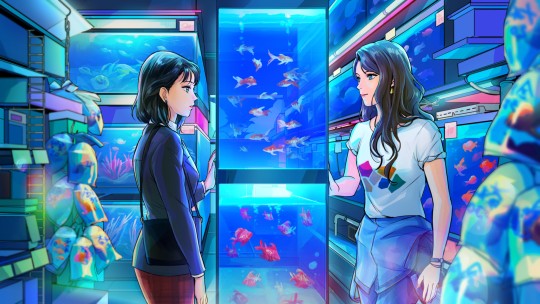
A Summer’s End – Hong Kong 1986 is a Yuri visual novel set, as you may have figured out, in Hong Kong in the year 1986. The game follows a young office worker, Michelle (Fong Ha) Cheung, who has a chance encounter with a free-spirited woman named Sam (Ka Yan) Wong. Both women feel drawn to each other, and the game explores this mutual attraction and the budding relationship which emerges from it.

This plot follows the standard girl meets girl story that has permeated the Yuri genre for the past several decades. Like most Yuri stories, the older and more experienced woman, Sam, is rebellious and beautiful, with long dark hair and a dominating persona. Michelle, although far more naive in the ways of love, breaks the trend of this trope by being the more sullen of the two. I would have liked to see the game diverge a bit more from the standard story of the genre. Fortunately, A Summer’s End is a romance story between adults who do not work together, setting it apart from the norms. It even includes a coming out section that creates a more robust LGBT identity than any tale of temporary schoolgirl love.
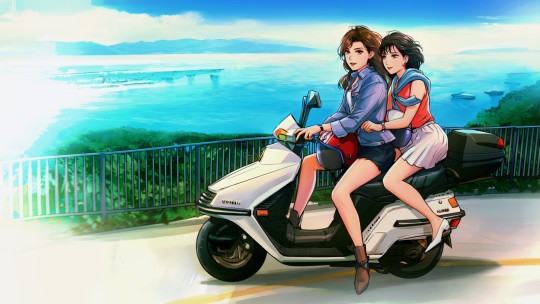
The story is well put together and well presented. The story is told primarily from Michelle’s perspective. It mostly takes place over a few days, during which Michelle engages in a whirlwind romance with Sam. This story features the struggle between her feelings and passion and her devotion to tradition and her mother. The progression of her affection is unrealistically fast. The story feels a bit rushed, and many of the societal and personal quagmires the game stumbles upon are not sufficiently developed or confronted. Had the game indulged in a more prolonged and tumultuous struggle for Michelle, conclusions would have felt much sweeter, and the story would have gone from good to great.
Even with this massive missed opportunity, there are plenty of exemplary moments and aspects of the narrative. The game pulls no punches addressing Michelle’s slightly overbearing mother and the conflict between the two. It would have been incredibly simple to take the easy route on this one. Still, the developers stuck to their guns and manage to explore a challenging situation satisfyingly, all while keeping the characters realistic and sympathetic. In fact, every scene relating to LGBT rights and history is flawlessly executed.
There are also some fantastic chapters, including a thrilling but refreshing bike ride and a flashback scene that recontextualizes certain events from another perspective. The many references and allusions to classic cinema including some older lesbian films and plenty of Asian works, are particularly noteworthy. However, the best part of A Summer’s End by far is the setting.
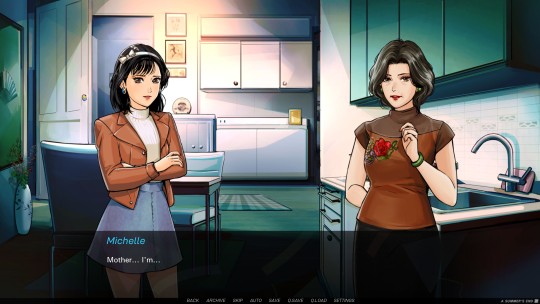
The location and time period is intrinsic to Sam and Michelle’s tale, as it is shaped by and reflects contemporary culture and LGBTQ rights. Oracle and Bone create a vibrant and lively world, a jaw-dropping depiction of Hong Kong in the 1980s. Everything helps feed into the creation of this world, including a fantastic and retro UI, small touches such as a Cantonese subway announcement, and objects encountered like a disposable camera help convey a strong sense of the period. However, the soundtrack sells it more than any other element, save perhaps the artwork, transporting the player to the era. While a few tracks are the standard easy listening affairs one expects from visual novels, there are tons of excellent city pop and disco beats, complete with plenty of synths and confidence! Finally, a visual novel soundtrack that contributes more than just background noise!

Sadly, the game’s dialogue choice system and branching paths are far more of a hindrance than a help. I can honestly say that the game would play better and be way more enjoyable as a kinetic novel. Most choices feel inconsequential, changing nothing of the story and resulting in almost the exact same response from other characters yet, they have a hidden points system. If you do not earn enough points, parts of the optional adult content will be unplayable until one goes back to find the right choice. I spent several hours replaying, and eventually skipping through, the game to unlock all the scenes, and finally gave up with one CG left unseen. The only choice with any actual effect is painfully evident in its consequences. One option leads to the bad ending, which is well written, but no reasonable player would go down that path unless they just wanted to see the whole game. The second unveils the true good ending, which no player in their right mind would not pursue, as again, the choice is obvious and adds nothing to the game. There is no reason to put in an alternative ending or tedious dialogue choice.
The characters in A Summer’s End are well constructed. Sam is adventurous without being obnoxious and has a mature though appropriately unrefined demeanor. Michelle is extremely curt and somewhat distant, although she displays a sharp wit and more timid nature on occasion. Both women participate in engaging, deep, and thoughtful discussions, often with each other, although sometimes internally, and thus feel well developed and complex. Unfortunately, their chemistry, while not absent, is not enough to sell the whirlwind romance. There is insufficient expression of their feelings and attractions, both internally or through dialogue and actions, so their inevitable closeness feels unearned.
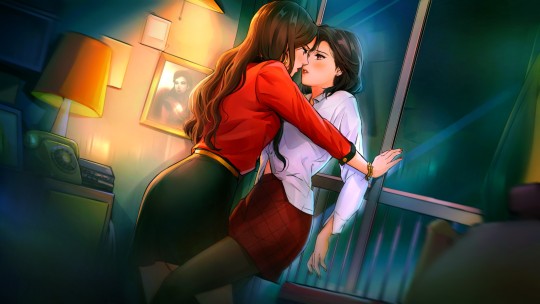
However, even in the short game, both characters change with each other, especially Michelle, as she becomes more affectionate, confident, and caring. She begins to embody some of Sam’s warmness while never losing herself. Some of my favorite dialogue and interaction came from her towards the end of the game, although I will not spoil it. Additionally, side characters have a strong presence thanks to their firmly established characteristics and a profound effect on the narrative. Each has their own sprite and mannerisms, helping cement them as fixtures in A Summer’s End rather than tacked on assets.
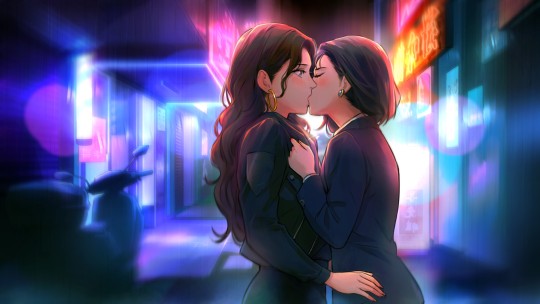
The visual novel contains optional adult content, which is installed in an extra patch and can be toggled on and off. I played through the game with and without it and can happily report that the story is just as fulfilling and complete without it. Although the unlockable nature of these scenes is aggravating, they are very well written and sensual without being exploitative. There were moments I did not care for as much, such as Sam getting carried away at one point, but it felt very realistic and incredibly sensual. The artwork in these sexual encounters is some of the best in the game, embracing darker colors and showcasing intense desire.
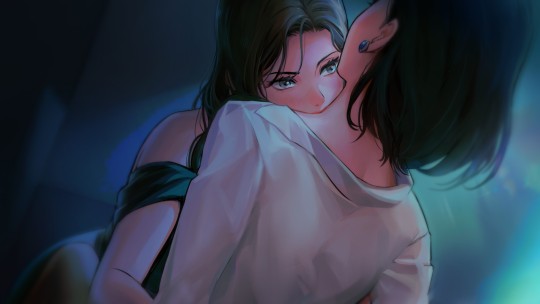
Speaking of the artwork, it is stupendous. The game is bright and striking, with amazing backgrounds complete with luminous neon signs, glaring televisions, and life and activity oozing from every corner. The backgrounds are so beautiful and detailed they could effectively serve in place of CG art, although there is plenty of that asides. The character models and designs are similarly excellent, with expressive poses and faces. The various outfits, of which the game has many, embody iconic 80’s fashion. Artist Tida Kietsungden draws both the characters and CGs with a distinctive hand-drawn style, which allows them to play well off each other and add to the beautiful presentation. The detail and care that went into the aesthetics are enormous and elevate the game at every moment.
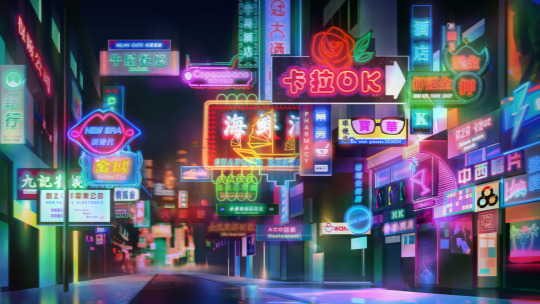
A Summer’s End – Hong Kong 1986 is a vibrant and intimate experience. The fantastic setting and flawless artwork surround a compelling and thoughtful story about lesbian love and desire, societal expectations, and the bonds between family and lovers. It is rough around the edges, with a slightly rushed story that leaves little time to wallow in complexity and an awful dialogue system. However, it will win players over with its striking presentation and sophisticated subject matter. I look forward to more from this studio and highly recommend you check this game out!
Ratings: Story – 7 Characters – 6 Art – 10 Music – 8 LGBTQ – 8 Sexual Content – 3 (8 with patch) Final – 7
Purchase A Summer’s End on Steam and itch.io, available April 23
Consider supporting Yuri news, reviews, and content on the YuriMother Patreon
#Yuri#lgbt#lgbtq#lgbtq+#queer#gay#reivew#a summer's end#hong kong#girls love#gl#wlw#lesbian#visual novel#games#video games#gaming#manga#anime#reviews
2K notes
·
View notes